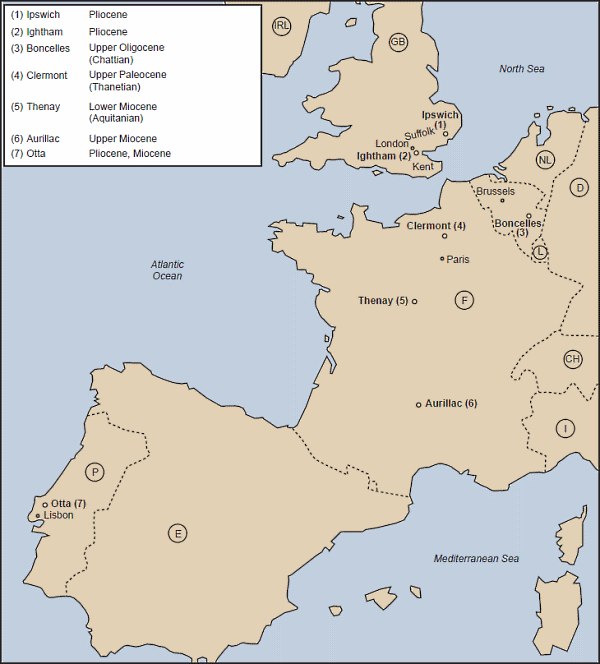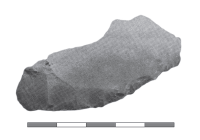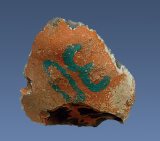The views expressed in this paper are those of the writer(s) and are not necessarily those of the ARJ Editor or Answers in Genesis.
Abstract
Approximately between 1860 and 1930, in some cases even later, there was a discussion about flint findings from Paleocene to Pliocene strata which were similar to tools. The findings show typical marks of human processing. Nevertheless they were rejected as human relicts on the grounds that they had been formed by geological processes. But after decades of research there is still not the least indication of any reasonable scientific support for this statement. The actual reason for the rejection of these findings is their occurrence, which within the scope of the evolutionary paradigm is too early in geological history. They are a contradiction to any evolutionary theory about the origin of man, and they contradict the conventional long time periods.
Keywords: Aurillac, Belle-Assise, Abbé Bourgeois, Henri Breuil, conventional timescale, eolith, Mantes, Aimé Rutot, Tertiary stone tools, Thenay, paleoanthropology, human evolution, short chronology, Max Verworn
Introduction
According to today’s prevailing opinion the first manufacturers of stone tools were australopithecines and habilines living at the end of Tertiary about 2.5 million isotope years1 ago (Semaw 2000). According to the evolutionary model the first undisputed men (Homo erectus) descended from these “ape-men” living solely in Africa and made headway toward Eurasia about 1.8 million isotope years ago, during the early stage of the following younger geological period, the Quaternary. Thus, stone tools found outside of Africa cannot be of pre-Pleistocene age.
There are, however, stone tools from pre-Pleistocene epochs which were discovered not only in upper, but also in middle and lower strata of the Tertiary, and to be more precise, in different locations in Western and Central Europe, from Portugal through France to Britain, Belgium, and Germany, as well as outside of Europe. Inspired by the reading of Michael A. Cremo and Richard L. Thompson’s book Forbidden Archeology (1994, 2005) I concentrated on these findings.
I visited numerous museums and institutions of universities in Europe (Britain, France, Germany, Belgium) and had access to many original findings from the Tertiary which are not accessible to the public—in 2004 and 2009 the British Museum (London) and the Maidstone Museum & Bentlif Art Gallery (Maidstone); in 2004 the Ur- und Frühgeschichtliche Sammlung der Friedrich-Alexander-Universität (that is, the Prehistoric and Protohistoric collection of the Friedrich Alexander University Erlangen-Nuremberg, Erlangen); in 2004 and 2006 the Landesamt für Denkmalpflege und Archäologie (that is, the State Office for the Preservation of Historic Monuments and Archeology, Saxony-Anhalt) and the Landesmuseum für Vorgeschichte (that is, the State Museum for Prehistory, Halle); in 2005 the Museum für Ur- und Frühgeschichte Thüringens (that is, the Museum of Prehistory and Protohistory of Thuringia, Weimar) and the Institut royal des Sciences naturelles de Belgique (that is, the Royal Museum of Natural Science in Belgium, Brussels); in 2005 and 2007 the Museé d’Art et d’Archéologie (that is, the Museum of Art and Archeology, Aurillac); in 2008 the Oxford Museum of Natural History; and in 2009 the Sammlung des Seminars für Ur- und Frühgeschichte und Vorderasiatische Archäologie (that is, the Collection of the Department of Prehistory and Protohistory and Archeology of the Middle East) Ruprecht-Karls-Universität, Heidelberg. There I held many eoliths2 in my hands, among them findings from the Kent Plateau and East Anglia (Britain), Aurillac (France) and Boncelles (Belgium), and I was allowed to take photographs of quite a number of examples and had replicas made. In addition, I contacted stone tool experts from Britain, France, Belgium, and Germany. This project would not have been possible without their expertise. On request of the author they matched, with the help of photographs and drawings, Tertiary stone tools to fairly similar younger tools (drills, pointed tools, scrapers, hammerstones, etc.), as did the author, and thus confirmed that a majority of the Tertiary findings obviously are real human-made stone tools. They also assessed original photographs and replicas of the flint findings. Finally, I added illustrations of similar tools from the recent specialist literature to illustrations of a number of Tertiary stone tools.
It is not my goal to plead that all eoliths in possession of museums are real tools. In my opinion a number of these deposited findings are natural products, or at least questionable artifacts. Still many eoliths, especially the published ones, show unmistakable signs of being real human-made tools.
The reasons that led to the rejection of Tertiary stone tools by the scientific community will be explained.
Accepting these stone tools as human-made, and thus by implication the fact that man thus had already existed in the Tertiary has substantial impact on our conceptions of the origin and history of man. In Vergessene Archäologie (that is, Forgotten Archeology), the author (Brandt 2011a) reported stone tools of almost the same age as dinosaurs, and he extensively examined this fact. In this paper the examination and explanation of this evidence will enable the English-speaking audience to access these important findings on this topic.
Tools from the Lower Miocene found at
Thenay in France
First report of Tertiary stone tools in 1867 At the meeting of the International Congress of Anthropology and Prehistoric Archeology in Paris in 1867 the French Roman Catholic clergyman Abbé Bourgeois (1819–1878) read a report on flint tools from the Tertiary3 which he had found on the ground at Thenay in France (fig. 1). Thus, Bourgeois was the first researcher to report on tool findings from pre-Pleistocene (pre-Ice Age) strata. Many other researchers were to follow.
As a result of comparing the Tertiary tools to younger ones Bourgeois came to the conclusion that they were tools of a similar kind (fig. 2). The Tertiary stone tools were—just as tools from later periods— ideal for cutting, drilling, scraping, and hammering. The tool findings from Thenay show nearly every sign of being processed by humans, including retouching (fig. 3), artificial marks, signs of use, and above all, a recurring of certain types (Bourgeois 1868, pp. 70–71). Prior to this evaluation Abbé Bourgeois worked intensively on stone tools. Thus, more than 30,000 stone tools passed through his hands during the years between 1863 and 1865 (Bourgeois 1877, p. 562).
At Thenay the Beauce Limestone, which covered the processed tools, had even then been allocated to the Aquitanian stage (de Mortillet 1883, p. 86; Mahoudeau and Capitan 1901, pp. 132–136, fig. 4). This designation has not changed since then (Pomerol and Feugueur 1974, p. 142; Pomerol 1982, p. 160).The Aquitanian, being the lowermost stage of the Miocene epoch, is now dated to be 20.4 to 23.0 million isotope years old (Gradstein et al. 2012, fig. 5).
Abbé Bourgeois showed a number of flint stones to various researchers. Most of them rejected them as tools. The main reason for the common rejection of these flint tools was their old age, according to the famous French prehistorian de Mortillet (1883, pp. 86–87). Yet why did stone tools from the Aquitanian represent such an outrageous provocation for many people?
The age of the stone tools—a challenge
When discussing the Thenay stone tools, which were found in sediments from the middle Tertiary, one has to keep in mind that only recently has there been a scientific revolution leading to a considerable extension of the duration of the history of mankind. Until the middle of the nineteenth century the opinion prevailed that man did not appear prior to geologically modern times (the Holocene epoch) (Wiegers 1928, p. 1).
In 1839 Jacques Boucher de Perthes (1788–1868), a head of the French customs authorities, found stone tools along with bones of an ancient elephant and the Merckish rhinoceros in river sediments of the Somme River near Abbeville (northern France) (Wiegers 1928, p. 4) (see fig. 1). His findings did not meet with a favorable reception. Yet, Boucher de Perthes did not allow himself to get discouraged. Step by step he succeeded in convincing the most distinguished French and English scholars. In 1863 Charles Lyell published for the first time a comprehensive description of the oldest findings of humans of the post-Pliocene (Pleistocene epoch) period of Britain, Belgium, France, and Germany in his famous book Geological Evidence of the Antiquity of Man (Wiegers 1928, pp. 4–5, 8). Only four years later Abbé Bourgeois’s report on stone tools, which were much older according to conventional chronology than those which had only been accepted after many discussions, burst onto this stage of research. Having made efforts to accept human remnants from glacial sediments (formerly allocated to the Flood), now the history of mankind was said to date back to a time much earlier than the Ice Age into a completely alien world of animals and plants.
The subdivision of the geological timetable of the Cenozoic era (fig. 5) into the epochs was the same at the time of Abbé Bourgeois’s discovery as it is now, except for the Paleocene (Stephan 2010, p. 110). The timetable indicates the beginning of mankind according to common conviction before 1860, later than 1860, today, and with the acceptance of Bourgeois’s tool findings from the Aquitanian of Thenay.
Three other Tertiary locations where stone tools were found in Europe will be discussed subsequently. However, to begin with, characteristic features of stone processing will be considered.

Fig. 2. (1) Flint flake from the Lower Miocene of Thenay with a percussion bulb and a tip formed by retouching of edges according to Bourgeois. This tool type is common in all epochs of the Stone Age according to Bourgeois (after Bourgeois 1877, p. 573, fig. 1a, b). One unit of the bar is equivalent to 1 cm (0.3 in) in this figure and all other figures. The entire bar in this figure is therefore equivalent to 3 cm (1 in). (2) Denticulated convergent scraper made from a flake. Flint, Middle Paleolithic, Combe-Capelle Bas, Dordogne, France. (Photographs: Michael Gleim).
Features of Processing Stones by Humans from Today’s Point of View
Manufacturing of stone splinters by “prehistoric” humans
The “prehistoric” human manufactured his stone tools mainly from round or squared pebbles and rock flakes available to him. He formed many flakes by freehand percussion, that is, by hammering against a core using a hammerstone. Apart from this standard technique the “prehistoric” human used a bipolar technique, an anvil technique, and from time to time he tossed scree material against an anvil stone to produce flakes and fissile material (Feustel 1985, pp. 47–53; Schick and Toth 1993, pp. 118–122).
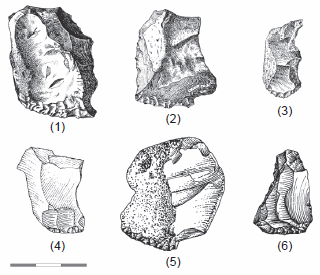
Fig. 3. (1)–(3) Flint fragments burst by fire from the Lower Miocene of Thenay with regular retouching. de Mortillet and de Mortillet called attention to the fact that the retouching can only be observed on one side and only at one edging (after de Mortillet and de Mortillet 1881, pl. 1, fig. 5–7). (4) Flaking tool according to Mania. Flint, Middle Paleolithic, Neumark-Nord, Germany (after Mania 1997, p. 178, fig. 128.3). (5) Disc according to Adrian with scraping edge. Flint, Paleolithic, Stukenbrock-FW, district of Gütersloh, Germany (after Adrian 1982, pl. 272, 13.367). (6) Scraper with slightly rounded retouching according to Adrian. Flint, Paleolithic, Borgholzhausen-Cleve, district of Gütersloh, Germany (after Adrian 1982, pl. 141, 14.533). One unit of scale bar = 1 cm (0.3 in).
Stone flakes and stone fragments formed through natural processes
There is no documented situation in which large amounts of stone flakes were formed by percussion, that is, by hammering with high velocity. However, there are circumstances in which small amounts of percussion flakes can be formed. Such procedures occur on a few beaches caused by high energetic waves while there are storms over the ocean (Carter 1980, p. 105; Oakley 1972, p. 11), and by falling stones (Clark 1958).
Natural processes which result in flaking stones usually take place at a low velocity (Luedtke 1986, p. 58). When masses of soil or ice (moraines, solifluction, cryoturbation, movement of ice floes) are being moved easily conditions arise where stones are put under pressure (Hahn 1991, pp. 42–47). Thus, flakes are often formed naturally (Patterson 1983, p. 299). The differences of features between flakes formed by slowly increasing pressure or by percussion are stated below.
Thermal processes
Often flakes are also formed by thermal processes (frost, temperature changes on a daily basis). Usually they are easy to discern, because the flakes do not have any striking platforms, bulbs and ripple lines (fig. 6).
Stones are also shattered during volcanic processes. Those tephrofacts may sometimes show a similarity to real artifacts, such as, for example, choppers and chopping tools. However, they can generally be easily distinguished from real artifacts. Contrary to anthropogene detachments, the detachment points of flakes on tephrofacts are very often impossible to determine, and most flake scars occur in random arrangements (Raynal, Magoga, and Bindon 1995, pp. 131, 136). Fig. 7 presents numerous tephrofacts. These examples deal with pebbles showing many detachment negatives, as well as detachments with small and even larger more or less irregular flakes.
Tephrofacts show a great diversity. They do not at all resemble any real simple tool inventories from the Tertiary and the early Pleistocene (consisting of, for example, scraper types, drills, pointed tools, hammerstones, cores, choppers). This is not meant to exclude the fact that natural processes like volcanic incidents may form occasional stones resembling simple artifacts to some extent.
Characteristics of flakes made by man and formed through natural pressure
Flakes produced by humans show typical characteristics (fig. 8). Among these characteristics is a bulb, striking platform, flake scars, ripples, and detachment negatives on the dorsal surfaces of the detachments and on cores. On fine-grained material such as flint, chert or obsidian they are better elaborated than on coarse-grained material, such as quartzite or porphyrite (Patterson 1983, p. 300; Schick and Toth 1993, p. 95).
Percussion produces a distinct bulb on the ventral surface of the detachment at a high rate. On the other hand, a pronounced bulb is generally not formed by pressure. A distinct bulb is a key characteristic to identify detachments made by men using percussion (Patterson 1983, p. 300).
Flake scars (éraillures) often occur as a result of percussion flaking, but only rarely from pressure splitting (Patterson 1983, p. 300).
A detachment platform is an important hint of human percussion splitting (Feustel 1972, p. 26), especially when the platform had been prepared prior to percussion (Patterson 1983, p. 302). Naturally fractured stones often lack a striking platform, or it is rather small and irregularly shaped (Feustel 1972, p. 26).
Usually a human hammers a couple of layers of flakes from a core. Consequently, only the few outward flakes are covered with a cortex. The majority of detachments, however, show scars from previous strikes on the dorsal surface, which were done when those detachments were still part of the core. On the other hand, only a few flakes are detached by natural splitting, so those flakes are usually covered with cortex, but they hardly have any scars from previously detached flakes (Patterson 1983, p. 302; Patterson et al. 1987, p. 98).
Cores bear scars from flakes detached by percussion. These scars are carvings with a concave, almost smooth surface. They are the negative forms of the detached flakes. The more the cutting process of the core continues, that is, the more flakes have been detached from the core, the more flake scars can be covered by later flake scars, and thus be defaced (Schick and Toth 1993, pp. 94–95).
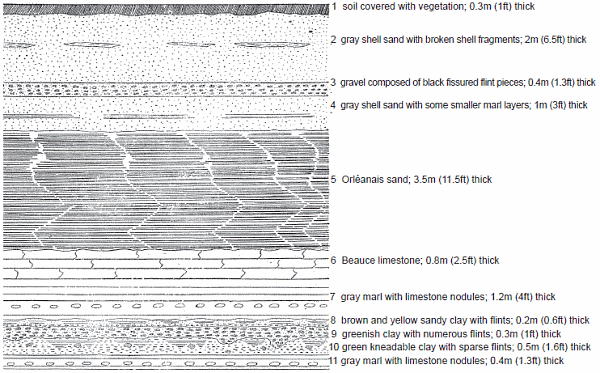
Fig. 4. Outcrop in the vicinity of Thenay according to d’Ault du Mesnil. The worked flints originate from strata 8–10 (after Mahoudeau and Capitan 1901, p. 141, fig. 39).
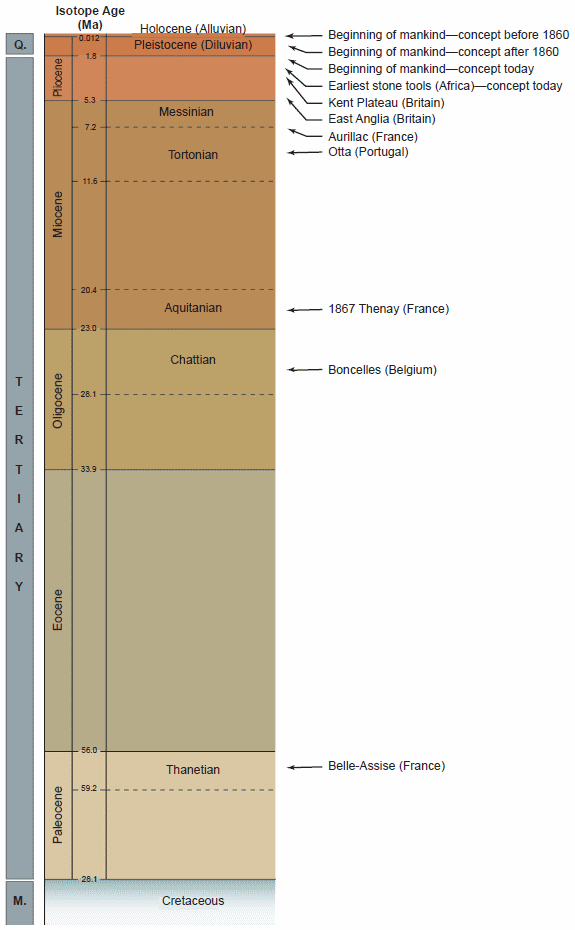
Fig. 5. Geological timetable of the Cenozoic era (Tertiary and Quaternary) with radiometric ages (Gradstein et al. 2012) and designation of the changing concepts about the beginning of humankind, the oldest tool findings according to today’s concept, Abbé Bourgeois’s tool findings, and later Tertiary tool findings as stated in the first important publication(s). The beginning of the history of man was shifted from Holocene back to Pleistocene after a long discussion around 1860. Just some years later the tool findings of Bourgeois called for a further backshift of this time, now for millions of years according to conventional time concepts. The tool findings of East Anglia, Otta and of the Kent Plateau will not be discussed here.
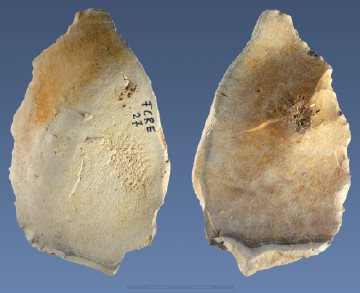
Fig. 6. Convex side scrapers from a large crack caused by frost. The flake does not show any detachment marks. On the non-domed surface the right edge shows a continuous retouching made by a human. Flint, Lower Paleolithic, Bergerac, Dordogne, France. (Photographs: Michael Gleim). One unit of scale bar = 1 cm (0.3 in).
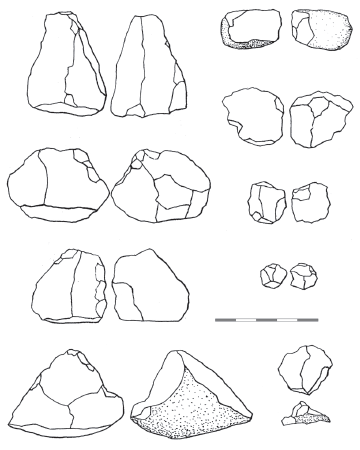
Fig. 7. Fractured stones (granite and quartz) produced by volcanic processes from Blassac (Haute-Loire) from the Central Massif in France (after Raynal, Magoga, and Bindon 1995, p. 134, fig. 3). Single geofacts by volcanism (tephrofacts) may show a certain similarity to simple tools. However, it is not possible to make up a tool inventory from tephrofacts and other geofacts. One unit of scale bar = 1 cm (0.3 in).
Edging chips made by man and nature
Accidental forces in nature cannot produce unifacial and unidirectional large retouched edges. However, these forces are to a much lower degree able to flake off a complete group of tools from one surface. Fig. 9 presents a unifacial scraper experimentally produced by percussion with a strong hammer, whose production by natural forces is rather unlikely (Patterson 1983, p. 303).
Physical natural processes and other incidentally working forces (for example, animal hoofs) may cause damaging of edges. Usually these are bifacial, short, steep transversal flake scars running across the edges (fig. 10). Natural unifacial one-sided damages of the edges generally do not have a uniform retouching pattern (Patterson 1983, p. 303). Fig. 11 presents a detachment piece with irregularly chipped edges, which was transported in a river.
In the crusher
In Texas Patterson examined crushed chert stones that had been ground in mechanical crushers. According to Patterson this process of crushing stones can be compared to incidental natural processes exerting pressure. Certainly nature does not often exert such an intensive local pressure as mechanical crushers do, but the broken chert showed which features can be expected on stones having been put under incidental, nonspecific pressure. This pressure produced a high number of flakes. However, the flakes lacked the characteristic features of flakes having been produced by human percussion. Instead of those there were the typical features of being detached by pressure. On many flakes the ventral surface was rather plain. Most flakes did not have a bulb, and a good portion of them did not show a percussion platform. When there was a bulb it had a shape which was not comparable to the one on flakes produced by human percussion. The broken stones did not have long edges with unifacial chippings, and among the huge number of crushed stones there were extraordinarily few cores resembling artifacts (Patterson 1983, p. 306).
Zonal structure
A frequent criticism concerning stone collections from supposed prehistoric human finding sites is that the gathered collections are not representative, as only those stones which resembled tools were collected from all available stones. Therefore, it was taken for granted that a great number of tool-resembling stones were found among the huge numbers of broken rocks. This criticism assumes that when breaking many rocks nature is able to produce a considerable amount of stones similar to those manufactured by humans. This assumption has still not been confirmed. Even if natural forces leave behind an accumulation of broken rocks in some places, the material does not exhibit a high proportion with tool-resembling features. According to Patterson artifacts are concentrated in small regions because the stone manufacturers worked in certain places, whereas in regions with a huge number of naturally broken rocks no, or rather few, tool-resembling pieces are to be found (Patterson 1983, pp. 298–299).
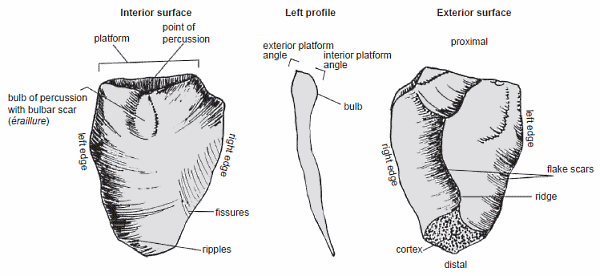
Fig. 8. Flake of human origin with typical characteristics and landmarks (redrawings after Debenath and Dibble 1994, p. 13, pictures rotated by 180°, few terms were omitted and the term bulbar scar [éraillure] was added).
Fig. 9. Unifacial scraper with long, uniform, parallel detachment scars shaped experimentally by percussion. According to Patterson it is unlikely that such a tool is shaped by incidental forces of nature (after Patterson 1983, p. 303, fig. 2). One unit of scale bar = 1 cm (0.3 in).
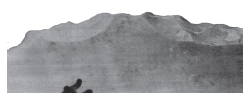
Fig. 10. Typical natural damage of the edging on a stone flake which occurred in flood waters of a river. According to Patterson incidental natural forces cause uneven chipping scars which are short, steep and running across the edge (after Patterson 1983, p. 303, fig. 3).
Fig. 11. Irregular edge chippings on a flake, which occurred while being transported in a river (after Hosfield, Chambers, and Toms 2007, p. 214, fig. 191). During their experiments in Wales, Hosfield, Chambers, and Toms (2007) embedded bifaces and flakes from flint and chert into the bottom load at two locations in the Afon Ystwyth. The flakes were being transported by the river up to 85 m (280 ft). Thus little chippings occurred at the edges reminiscent of deliberate retouchings according to the authors. These accidental natural chippings, however, are clearly distinguishable from retouchings intentionally manufactured by humans.
The well-known German prehistorian Alfred Rust (1965, p. 42) wrote that pseudo-artifacts were always found sporadically. Technically they varied greatly between each other. Hahn (1991, p. 44) also observed that with all naturally formed geofacts a certain regularity is missing, in contrast to artifacts. Rust (1965, p. 42) continued that artifacts, in contrast to geofacts, can be found many thousand-fold in closely bordered areas that had been human campgrounds and activity areas, or for example re-embedded with other broken rocks along rivers.
Schick and Toth (1993, p. 96) stated, with regard to frequency and zonal structure of artifactoid geofacts: “. . . any misleading stones are usually few and far between.”
The German prehistorian Lutz Fiedler, who is quite familiar with stone tools, writes with regard to the chance of natural forming of crude artifacts, that as far as old Paleolithic stone tools are concerned it is sometimes not easy to tell real ethnic artifacts, which were mostly formed without any considerable efforts, from naturally formed sharp-edged by-products. However, where numerous chipped objects occur in a limited site in a geomorphologically suited situation, doubts can be set aside (Fiedler 1997a, p. 2).
And Carter (1980, p. 96) commented on the frequency of forming geofacts as follows:
The biggest myth in American archeology is that nature breaks rocks by percussion and pressure with considerable frequency and that this breakage reproduces human work. . . . Few myths have less substance or greater persistence.
A concentration of findings in a small area showing typical anthropogene features therefore is an important hint to human activity.
Tools from the Upper Miocene at Aurillac in France
First findings
After Abbé Bourgeois had reported on stone tools from Tertiary sediments near Thenay for the first time in 1867, only two years later the public was informed about the discovery of a Tertiary stone tool in another location in France-Aurillac in the Department Cantal (Massif Central) (see fig. 1). This was the beginning of local research activity for decades by numerous scientists. Charles Tardy displayed a human-made flint blade (fig. 12) coming from a Tertiary sediment at the meeting of the Society of Anthropology in Paris on December 16, 1869. Many researchers, such as Hamy, G. de Mortillet, Broca, Leguay, Roujou, and Pruner-Bey, immediately recognized the evidence of human processing (Tardy 1869).
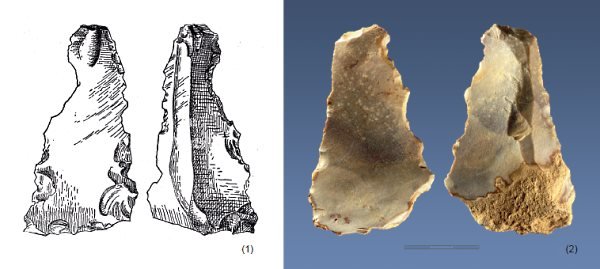
Fig. 12. (1) Blade-shaped flint flake with human detachment features (after Tardy 1869, p. 705). The finding is the first published artifact from sediments of the Upper Miocene of Aurillac. (2) Large blade-shaped flake with denticulated retouching on the right and the left side. Flint, Middle Paleolithic, Putances, Normandy, France. (Photographs: Michael Gleim). One unit of scale bar = 1 cm (0.3 in).
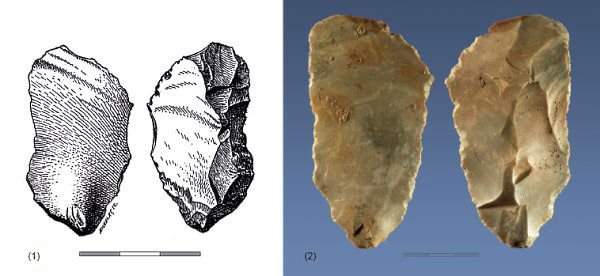
Fig. 13. (1) Flake, flint, Upper Miocene, Puy Courny (after Rames 1884, p. 400, figs. 211, 212). According to de Mortillet and de Mortillet (1900, p. 89) the (left) ventral side shows a striking platform and a striking point, a bulb of percussion, a bulbar scar and ripples. On the dorsal side detachment negatives and retouchings of the side edges can be observed. (2) Blade-shaped Levallois flake. Flint, Middle Paleolithic, Putances, Normandy, France. (Photographs: Michael Gleim). One unit of scale bar = 1 cm (0.3 in).
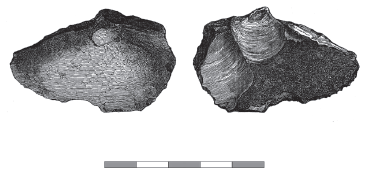
Fig. 14. Flake, flint, Upper Miocene, Puy Courny. According to de Quatrefages on the (left) ventral side a bulb of percussion and a striking platform can be observed. On the dorsal side there are two flaking negatives. At the distal edge and only on the dorsal side there are delicate chippings in the same direction (after de Quatrefages 1887, p. 95, figs. 97, 98). One unit of scale bar = 1 cm (0.3 in).
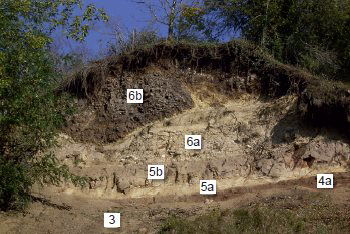
Fig. 15. Front view of the strip in the Puy Courny quarry. Above the eroded basanites (stratum 3 masked here by rubble) are red clay with a thickness of 1–2 m (3–6 ft) composed of kaolinite and gibbsite, easily recognizable in their red-colored layers (stratum 4a). Above these layers lie two layers of tephra layers in the 5a–5b. Above the top of the upper tephra layer 5b, which is impressively capped, lies the resuts of a debris avalanche (stratum 6a) that dragged along with it a block of basalt (6b) of several cubic meters in size (after Ernst and Gerard 2010, p. 39, fig. 13). (Photograph: Martin Ernst 2005).
| Layer | Thickness (m [ft]) | Lithology |
|---|---|---|
| 6b | >1.5 m (5 ft) | Large, by several fissures broken, black block of basalt, that was transported by a debris avalanche |
| 6a | 0.5–1.5 m (1.6–5 ft) unsteady | Base of the mixed (debris avalanche) breccia, whose matrix consists of light pumice. At Puy Courny it is superimposed by several tens of meters of breccia deposits |
| 5c | some | Basaltic stream of lava |
| 5b | 0.3–0.4 m (1–1.3 ft) | Grey pumice, tephra with fossil plant roots at the top |
| 5a | 0.5-0.6 m (1.6–2 ft) | Whitish pumice |
| 4b | 0.1 m (0.3 ft) | Coarse-grained quartz sands with remains of mammals and artifactlike flints (eoliths) |
| 4a | 1–2 m (3.5–6.5 ft) | Clay (kaolinite, gibbsite), red to light colors; probably fossil soil horizon, which may have originated in a tropical climate. |
| 3 | 1–4 m (3.5–13 ft) | Weathered purple basanite (clay weathering) |
| 2 | 20–25 m (65–82 ft) | Massive stream of lava (basanite) |
| 1 | ca. 40 m (131 ft) | Oligocene limestones and dolomites with flint layers. Throughout the entire sequence are found fossils of the gastropods Potamides lamarcki, Phanorbis sp., and Lymnaea sp. |
| Lower bed | Clayey gravels and sandy clays, partially as basal conglomerate above the Hercynic-Varistic crystalline basement, which is exposed in the valley bottom of the Cère River |
Until the end of the nineteenth century further artifacts could be retrieved from the Upper Miocene strata of Aurillac. Fig. 13 shows a flint flake from Puy Courny in the publication by Rames (1884, p. 400). Another flake from this site is from a publication by de Quatrefages (1887, p. 95), and is shown in Fig. 14.
Geological aspects with regard to the finding situation of eoliths
Recently Ernst and Gerard (2010) described in detail the geology and stratigraphy in the Aurillac area and especially the strata where the eoliths were found.
According to Rames and other researchers, such as Boule, Klaatsch, Marty, Mayet, Puech, and Verworn, the artifact-like flints come from sediments described as fluviatile sands. Even remains of mammals were found in these sediments. Opponents at that time, as well as supporters of the tool nature of these eoliths, unanimously agreed on the Upper Miocene age of the sands where the artifact-like flint stones and the mammal remains were found (Ernst and Gerard 2010, fig. 15 and table 1). However, findings of mammal remains are only fragmentary and few in number.
Finally Brousse et al. (1975, pp. 138–140) worked on the mammal relicts kept in the custody of the museums of Aurillac and Lyon. Among the mammal relicts were Deinotherium gigantheum, a rhinoceros species and the horse-like Hippotherium primigenium which had three toes. They are of the same kind as those found for example in the Dinotheria sands of Hessothuringia, the sediments at the Hegau volcano Hoewenegg or in late Tertiary fissure fillings of the Swabian Jura in Germany. They have been allocated to the Upper Miocene mammal zone MN 9 (Heizmann et al. 2003, p. 6; Stephan 2002, pp. 160–161).
The allocation of these tool-bearing strata at Aurillac to the Upper Miocene has not been challenged since the start of the eolith debate until now. Isotope datings verifying the biostratigraphic classification have been added, since the same isotope ages have been found as in other strata from the Upper Miocene with the same index fossils. Publications up to this time document that the artifact-like flint stones, as well as the mammal fossils, were obtained from a fluviatile sand horizon between two layers of volcanic rock (Ernst and Gerard 2010). For the basalt layers lying on top of and underneath this fluviatile sand layer isotope ages of 6.48 and 7.57 million years respectively were determined (Brousse et al. 1975, p. 135). The age of the chert tools lying in between these basalt layers would be about 7 million isotope years according to these datings.
Prior to the sedimentation of the respective Tortonium sands (stratum 4b in fig. 15) and the following main eruption of the Cantal volcano a sediment gap is assumed, an eventless time without any eruption (Brousse et al. 1975, p. 136). The weathered basanite (stratum 3) and the red claystones (stratum 4a) bearing kaolinite and gibbsite are considered proof. The paragenesis of both minerals and the typical decomposition have been ascribed to formation in a tropical climate (Ernst and Gerard 2010, p. 38). In this red clay horizon (stratum 4a) Vuittenez (1964, p. 21) observed some fragments of lithified wood. They might hint at a former forest cover. This tropical vegetation presumably attracted the herbivore mammals of the Tortonium.
Research boom at the beginning of 1900
Research of the Aurillac site experienced a considerable boom at the beginning of the twentieth century. Out of all the comprehensive and detailed results of this research, the ones made by Verworn will be discussed in detail.
Apart from physiology, Max Verworn (1863–1921) concentrated on early history and worked in this field of science. At the beginning Verworn was very skeptical of eoliths. However, after concentrating on the matter he changed his opinion. He made two excursions to Aurillac, in April and September, 1905 (Verworn 1906a, pp. 611–612). In the same year he published the results of his research during his first journey, a comprehensive, extremely systematic and well-illustrated work with numerous excellent photographs, under the title Die archaeolitische Cultur in den Hipparionschichten von Aurillac (Cantal) (that is, The Archeolithic Culture in the Hipparion Strata of Aurillac [Cantal]).
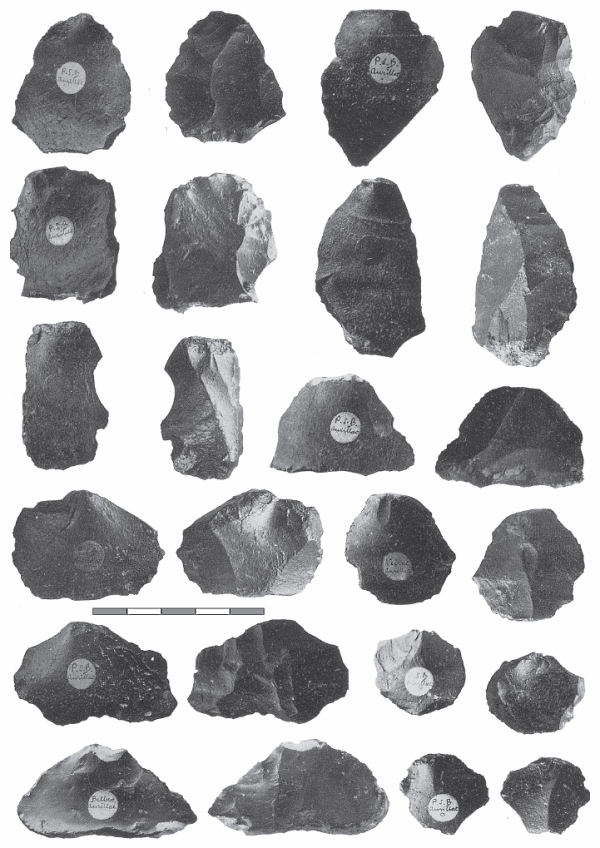
Fig. 16. Photographs of flint flakes from Upper Miocene sediments of Aurillac (Puy de Boudieu, Veyrac, Belbex) (after Verworn 1905, pl. 1, 2). One unit of scale bar = 1 cm (0.3 in).
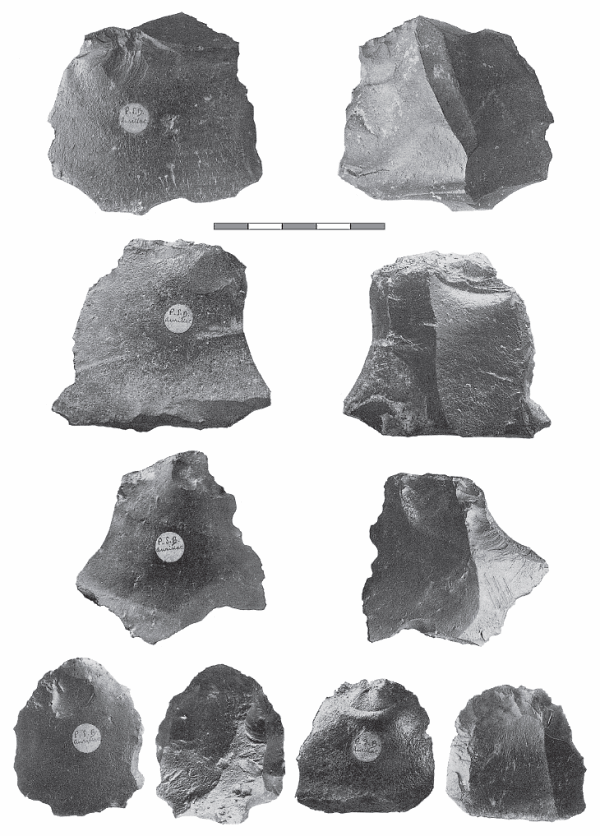
Fig. 16 (continued). Photographs of flint flakes from Upper Miocene sediments of Aurillac (Puy de Boudieu, Veyrac, Belbex) (after Verworn 1905, pl. 1, 2). One unit of scale bar = 1 cm (0.3 in).
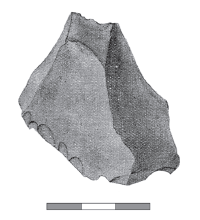
Fig. 17. Polygonal core, being also used as a scraper according to Verworn. Flint, Upper Miocene, Puy de Boudieu (after Verworn and Bonnet 1908, p. 61, fig. 1). One unit of scale bar = 1 cm (0.3 in).
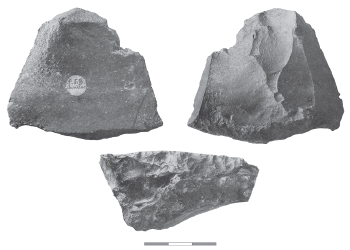
Fig. 18. Large thick flake with a bulb of percussion and a striking platform. The narrow sides are sharp alongside and without any chippings. The broad side has been treated with countless strikes pointing in the same direction. The back side shows scars of five previously detached flakes. Flint, Upper Miocene, Puy de Boudieu (after Verworn 1905, pl. 3, fig. 3). One unit of scale bar = 1 cm (0.3 in).
Verworn’s findings
In the following, flakes, cores, scrapers and crude tools for digging, scraping, picking, and hammering from the substantial materials he found will be described.
Flakes occur in great numbers. The typical features of human flaking, such as percussion platforms, bulbs, scars, fanned fissures, and bending of the fracture surfaces, are distinctly evident. There are, however, many flakes where the bulb part is no longer there, whereas their presence with other features such as fanned fissures, bending of the ventral surface, etc. makes the stones recognizable as genuine human-made flakes. The dorsal sides of the flakes display the cortex occasionally, but in most cases the scars from formerly detached flakes indicate that almost every time they were detached in the same direction. Now and then four or five detachment scars run parallel along the dorsal side, and the negative forms of the percussion bulbs are well preserved. Verworn was able to produce flakes from non-processed Miocene flint flags by his own hard hammering percussion, and those flakes were almost identical to the forms of Miocene flakes he found (Verworn 1905, pp. 32–33). Fig. 16 shows a number of the flakes from the Upper Miocene.
Verworn rightly stated, “Where many flakes are to be found there must also be the cores from which the flakes were detached.” In fact, he was able to dig up a huge number of flint flags showing negatives of flakings, as well as the negatives of the bulbs of these flakings. Sometimes there were quite a number of flaking negatives next to each other along the edge of a flag, being oriented mostly in the same direction and more rarely in the opposite direction (Verworn 1905, p. 34). Apart from those cores there were also polygonal cores (Verworn and Bonnet 1908, p. 60). The core stones occurred in any size corresponding to the dimensions of the flags. According to Verworn (1905, p. 34) some core stones were used as tools. Fig. 17 shows a polygonal core stone that was used as scraper.
The scrapers are the most important part of the collection (Verworn 1905, pp. 36–42). The majority of the scrapers consist of large and small flakes. Some scrapers, however, were made from natural fragments and smaller flags. Several scrapers show signs of use just at the cutting edge, while the other edges are absolutely sharp. Other scrapers show processing by a number of equally directed hammerings (fig. 18). Apart from processing of the edges, some scrapers had additionally been made to be suited to being grasped by the hand by the chipping off of the sharp edges and tips to prevent injuries when using the tool.

Fig. 19. (1) Large round scraper, flint, Upper Miocene. According to Verworn the scraping edge was shaped by several parallel strikes placed next to each other creating a slightly convex silhouette (after Verworn 1905, p. 39, fig. 9). (2) Convex scraper made from pebble. Quartzite, Lower Paleolithic, High Terrace of the Garonne, France. (Photograph: Michael Gleim). One unit of scale bar = 1 cm (0.3 in).
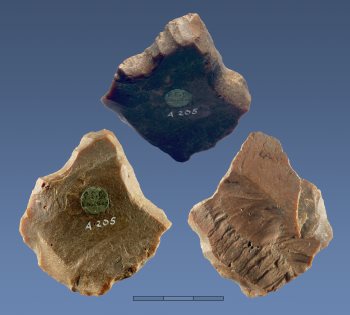
Fig. 20. Typical pointed scraper with a blunt tip made from a laminated piece of flint by carving out the tip. The comparison between the (left) ventral and the dorsal side shows that the strokes having formed the tip were all done in the same direction, namely from the dorsal side, and are therefore only visible on the ventral side. Flint, Upper Miocene, Puy de Boudieu, Collection of Max Verworn, Seminar für Ur- und Frühgeschichte und Vorderasiatische Archäologie, Ruprecht-Karls-Universität Heidelberg. (Photographs: Michael Gleim). One unit of scale bar = 1 cm (0.3 in).
Verworn subdivided his scrapers according to their form into straight, round, pointed, and hollow scrapers. Fig. 19 shows a large round scraper. The individual chipping marks along the edge appear at such regular intervals that according to Verworn (1905, p. 39) they bring tools of the Paleolithic or even Neolithic to one’s mind. The cutting edges of the scrapers may also be indented.
The pointed scrapers were formed by equally directed chippings on two sides. The shapes of the tips varied within large ranges—sharp or blunt, short or long, thin or thick. Fig. 20 shows a pointed scraper with a blunt tip, having been formed from a laminated piece of flint. Figs. 21 and 22 show some more particularly delicately-formed scrapers.
Hollow scrapers had cutting edges with a circular indentation. Thus they could have been used for scraping clean cylindrical objects such as branches, bones, etc. Their cutting edges were mostly formed by a couple of little one-sided chippings, though sometimes they must have been formed by a single strong strike. The indentations may be strongly curved, shallow, small or large.
Among the flint flags Verworn (1905, p. 42) discovered pieces that had been systematically processed, and thus were meant to serve for certain purposes. He found several pieces among those tools having tips which were formed by cutting off two neighboring edges. These edges, which are on both sides of the tip, were more or less distinctly dished with numerous large or smaller chippings. The remaining edges were not processed. The finding shown in Fig. 23 may also have served as a pointed scraper for cone ends.
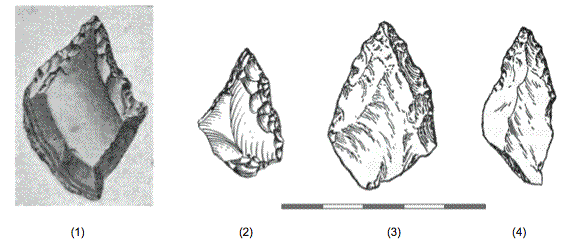
Fig. 21. (1) Pointed scraper with two equi-directional blades, on which according to Verworn both surfaces and the remaining edges are smooth. Flint, Upper Miocene, Puy de Boudieu (after Verworn and Bonnet 1908, p. 62, fig. 9). (2) Small, almost symmetric tip according to Adrian. Flint, Paleolithic, Borgholzhausen-Holtfeld, district of Gütersloh, Germany (after Adrian 1982, pl. 60, 14.068). (3) and (4) Awl according to M. D. Leakey. Quartz or quartzite, Lower Paleolithic, Olduvai Gorge, Tanzania (after M. D. Leakey 1971, p. 195, fig. 91.12, p. 217, fig. 106.5, © Cambridge University Press 1971, reproduced with permission). One unit of scale bar = 1 cm (0.3 in).
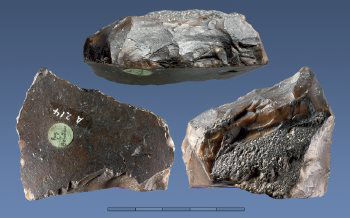
Fig. 22. A pointed scraper which was delicately worked on. Seen from the left is a smooth fracture surface and from the right a processed surface. The processed surface also shows leftovers of the crust. Both edges which meet at the top have been worked on by numerous large and small chippings. Flint, Upper Miocene, Puy de Boudieu, Collection of Max Verworn, Seminar für Urund Frühgeschichte und Vorderasiatische Archäologie, Ruprecht-Karls-Universität Heidelberg. (Photographs: Michael Gleim). One unit of scale bar = 1 cm (0.3 in).
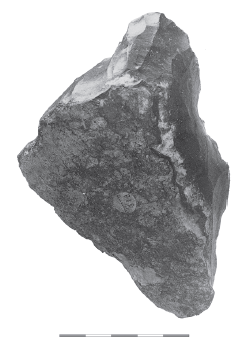
Fig. 23. Larger pointed tool for picking or digging, according to Verworn. The tool was manufactured from a natural flint plate. The surface of the artifact shows the flint crust and on the top the tip has been formed by numerous equi-directional strokes. Flint, Upper Miocene, Puy de Boudieu (after Verworn 1905, pl. 4, fig. 4). One unit of scale bar = 1 cm (0.3 in).
More recent discussion
In the falls of 1956 and 1957 Alfred Rust examined the collection from the Upper Miocene of Aurillac, which consisted of 7,000 objects, at the Geological Institution of Oxford University, which had been obtained by the Englishman Ernest Westlake (Rust 1957, p. 37).
These objects are furnished with indications of where they were found, and they often bear the label in situ (Rust and Steffens 1962, p. 67). Rust excluded 90% of the flint stones as geofacts, but the remaining findings were “overwhelming” as being man-made. Those eoliths were partially so exquisitely chipped that Rust had considerable doubts about their age (Rust 1957, pp. 37, 41).
In 1957 Rust was able to inspect the outcrop near Aurillac. There he found numerous artifacts (Rust 1957, pp. 41–42). Among the findings examined by Rust there were nose scrapers. Fig. 24 shows a nose scraper from the Upper Miocene of Aurillac from Max Verworn’s collection.
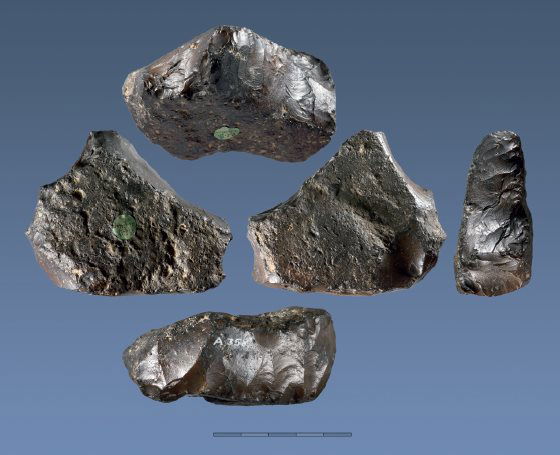
Fig. 24. Nose scraper from thickly layered rugged raw material with distinct processing of the edges. Flint, Upper Miocene, Puy de Boudieu, Collection of Max Verworn, Seminar für Ur- und Frühgeschichte und Vorderasiatische Archäologie, Ruprecht-Karls-Universität Heidelberg. (Photographs: Michael Gleim). One unit of scale bar = 1 cm (0.3 in).
Tools from the Upper Oligocene at Boncelles in Belgium
On September 30, 1907 Aimé Rutot, curator at the Museum for Natural History in Brussels, led 34 Belgian geologists and prehistorians to sand pits 8 km (5 mi) south of Liège where tools of different kinds, such as cut stones, anvil stones, knives, and scrapers, had been found. The tools came from a conglomerate layer in the lower strata of a sequence of sands from the Upper Oligocene. All of those present agreed on the fact that no objections to the justified explanation of the findings could be raised (Schweinfurth 1907). And although tool-like flints were found in even older strata in France shortly after that, the findings at Boncelles (see fig. 1) mark the most spectacular discovery of Tertiary stone tools. Today, the life and work of the explorer Rutot are all but forgotten. In the first two decades of the twentieth century, however, he was one of Europe’s most famous archeologists (de Bont 2003, p. 605).
The crude tools from Boncelles contributed to Rutot’s speculations with regard to evolutionary theory (Rutot 1919). However, the question about the nature of the tools among the Boncelles findings does not depend on these speculations. We know that there were people like the Tasmanian Aborigines who only had rather crude technical aids. Yet, the Tasmanian Aborigines were not “lower” people, but on a par with us. The degree of complexity of tools does not permit drawing conclusions about an “evolutionary degree of development” of the manufacturers. At any time there were people using rather crude tools.
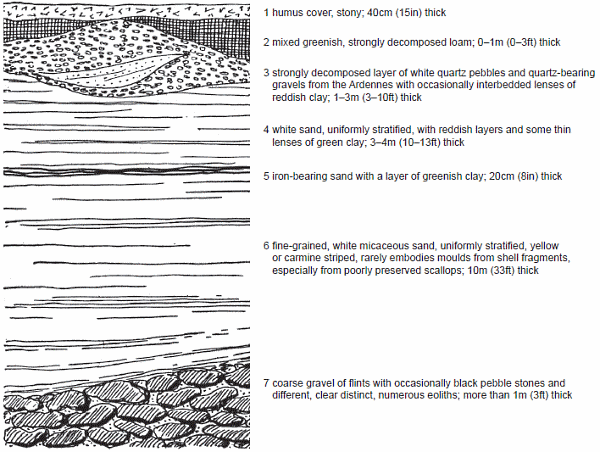
Fig. 25. Outcrop of a sand pit at Boncelles 500 m (1640 ft) east of the cross-way of Les Gonhir square. The geologic section was recorded by Rutot (after Rutot 1907, p. 443, fig. 1).
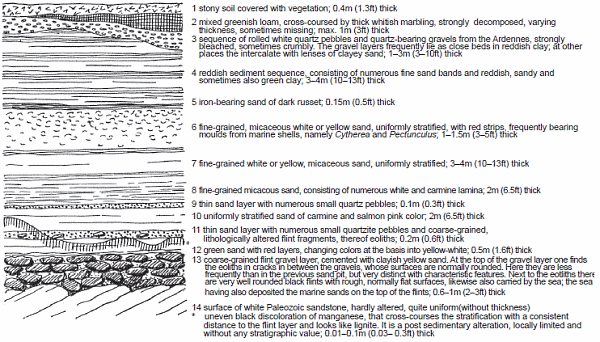
Fig. 26. Section of a further sand pit at Boncelles, 500 m (1640 ft) north-western of the sand pit of Fig. 25 (after Rutot 1907, p. 445, fig. 2).
The discovery of the stone tools
South of Liège, at Boncelles, the geologist Émile de Munck, who was familiar with stone tools, explored a sand pit. Among the pebbles of the pit he found some processed flint devices. De Munck reported his new discovery to Rutot. Workers had dug a small hole of about 60 cm (2 ft) depth into the bottom of the pit to gain flint stones as gravel for road construction. Thus, de Munck was able to retrieve several flint flakes with distinct features of human processing from the untouched layer, which consisted of yellow argillaceous sand. Rutot and de Munck jointly continued to excavate at Boncelles. The flint-stone layer measured about 1 m (3 ft) thick and was sitting on top of the Ardennen Sandstone, which had been allocated to the Devonian (see figs. 25 and 26). It was covered with about 15 m (49 ft) of marine sand and clay of Oligocene age. All in all Rutot and de Munck were able to dig up more than 100 excellent flintstone samples. Further tools were found at other sites at Boncelles (Rutot 1907).
Notably, Rutot was able to collect another several hundred tools during a second campaign lasting eight weeks. Thus, he then had available tenfold more findings compared to the material he owned when writing his first article in 1907. The tools he reported in 1907 came from less than 10 m3 (107 ft3) of excavated material (Rutot 1909, pp. 90, 94).
Geological situation
Rutot explained the geological conditions at Boncelles, which is located at the border of the Ardennes Plateau. On the plateau (between the rivers Maas and Ourthe) the flint-stone-bearing Cretaceous limestone (chalk) covers the Paleozoic of the Ardennes. During the Eocene this soft limestone was dissolved. The silica (flint) nodules, however, remained in the area to form the encountered Oligocene layer (“tapis de silex”) (figs. 25 and 26). At the beginning of the Upper Oligocene the sea returned and covered this silica nodules (flint) layer with 15 m (50 ft) of fossiliferous sands. Later, during the Middle Pliocene, layers of white fluviatile silica nodules (silica ooliths), as well as layers of sand and clay measuring 3 m (10 ft) thick, were deposited over the fossiliferous sands. Only after that time did the carving of today’s valleys begin. Apparently, humans must have roamed across the plateau, which was covered with silica (flint) nodules prior to the expansion of the Oligocene sea. Of course, today’s plateau had not been tectonically uplifted at that time, instead forming a lowland near the shore (Schweinfurth 1907).
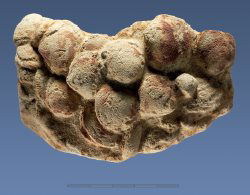
Fig. 27. Sandstone like conglomerate with red stripes and molds from shell fragments from upper Oligocene sediments (strata 6) at Boncelles, Collection of Max Verworn, Seminar für Ur- und Frühgeschichte und Vorderasiatische Archäologie, Ruprecht-Karls-Universität Heidelberg. (Photographs: Michael Gleim). One unit of scale bar = 1 cm (0.3 in).
Practically, Rutot’s geological interpretation and stratigraphic classification have not changed since and is still accepted today. In a pit located 500 m (1640 ft) to the north-west of the first place of discovery, as well as further tools index fossils were found, which secured the Oligocene age of the tools. Rutot named marine shells that are index fossils from the sand layer covering the tool-bearing silica nodules, among them Cytherea beyrichi (fig. 27). This fossil, as well as other designated species, are all found in the Upper Oligocene according to Rutot (1907, pp. 446–447). This determination is still valid. The sands from Voort and Boncelles, that is, the marine fossil-bearing sands, below which the layer with Rutot’s flint-stone findings is located, have been allocated to the Chattium, the uppermost stage of the Oligocene (Krömmelbein and Strauch 1991; Pomerol 1982, pp. 114, 119; Sierakowski 1970, p. 493). Today the age of this stage is stated to be 23.0 to 28.1 million isotope years (Gradstein et al. 2012). Rutot (1907, p. 448) concluded from the location of the tools at the bottom beneath the Upper Oligocene sands that they originated from the Middle Oligocene. Rutot’s conclusion is too general. However, it is possible that these flint-stone findings from the bottom of an Upper Oligocene layer originated from the Middle Oligocene, but that is not definitive. Since they at least come from beneath the Upper Oligocene sands they cannot be younger than that stratigraphic horizon. Because the geological circumstances are rather clear and have never been discussed controversially, all interest concentrates on the Boncelles findings.
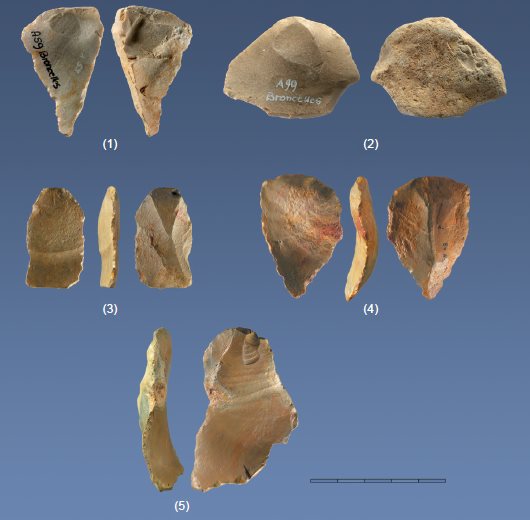
Fig. 28. Flakes, flint, Upper Oligocene, Boncelles, Belgium. Compare the samples to fig. 6. (1)–(2) Collection of Max Verworn, Seminar für Ur- und Frühgeschichte und Vorderasiatische Archäologie, Ruprecht-Karls-Universität Heidelberg.4 (3)–(5) Casts, Oxford Museum of Natural History. (Photographs: Michael Gleim). One unit of scale bar = 1 cm (0.3 in).
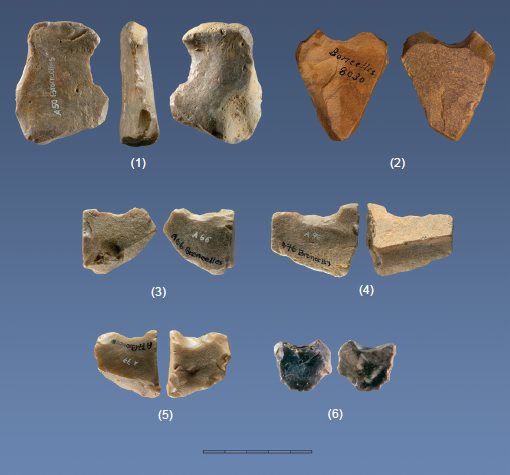
Fig. 29. (1)–(5) Hollow scrapers and respectively tools with notches. Flint, Upper Oligocene, Boncelles, Belgium. (6) Tool with a notch. Flint, Middle Paleolithic, Le Moustier, Dordogne, France. (2) Boncelles collection, Institut royal des Sciences naturelles de Belgique, Brussels. (Photographs: Martin Ernst). (1), (3)–(5) Collection of Max Verworn, Seminar für Ur- und Frühgeschichte und Vorderasiatische Archäologie, Ruprecht-Karls-Universität Heidelberg. (Photographs: Michael Gleim). One unit of scale bar = 1 cm (0.3 in).
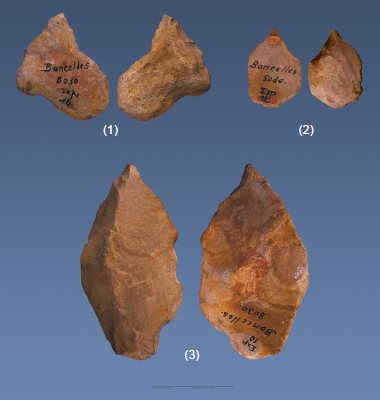
Fig. 30. Drills. Flint, Upper Oligocene, Boncelles, Belgium, Boncelles collection, Institut royal des Sciences naturelles de Belgique, Brussels. (Photographs: Martin Ernst). One unit of scale bar = 1 cm (0.3 in).
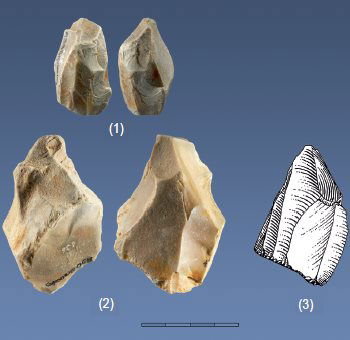
Fig. 31. (1) Small bipolarly-reduced double conical lamella core. Flint, Upper Oligocene, Boncelles, Belgium. (2) Core with several flake negatives and delicate chippings. Flint, Upper Oligocene, Boncelles, Belgium. Collection of Max Verworn, Seminar für Ur- und Frühgeschichte und Vorderasiatische Archäologie, Ruprecht-Karls-Universität Heidelberg. (Photographs: Michael Gleim). (3) Flat core with three reduction surfaces, according to Adrian. Flint, Paleolithic, Petershagen-Neuenknick, district of Minden-Lübbecke, Germany (after Adrian 1982, pl. 12, ns 152). One unit of scale bar = 1 cm (0.3 in).
The tools
Rutot (1907, pp. 451–468; 1909, pp. 95–100) described in detail the various tools from the Oligocene of Boncelles. The tools were formed from fragments or flakes. According to Rutot on 25% of the flint-stone flakes a bulb could be identified. Rutot subdivided the tools into types, such as those known from the Paleolithic. Among the artifacts of Boncelles there were hammerstones, flakings (fig. 28), anvil stones, knives, scrapers (fig. 29), drills (fig. 30) and cores (fig. 31). The materials among the Boncelles finds do not contain only single examples of well-known Paleolithic tool types, they also contain several examples of the same type.
Subsequent to his presentation of the Oligocene tools from Boncelles, Rutot mentioned an important reason for the actual tool character of his findings. He compared them to the tools of Tasmanian Aborigines of his time. Numerous tools in the Tasmanian Aboriginal collection are quite similar to those of the Oligocene of Boncelles. The only difference is that the Tasmanian Aboriginal tools were not manufactured from flint stones as the Boncelles tools were. Instead, they were formed from other stone materials such as quartzite, greenstone, and granite (Rutot 1907, pp. 469–478). There were different reactions to the Boncelles findings.
Positive reactions to the discoveries at Boncelles
The old age of the artifacts of Boncelles (Upper Oligocene) turned out to be a considerable problem for the prehistorians at the beginning of the twentieth century. At that time the concept of Tertiary humans in Europe was still being discussed, but tools ranging back to the early Tertiary (Oligocene) presented a major problem. Rutot was quite aware of this problem, as the title of his discovery report reveals: Un grave problème (that is, A grave problem). Yet, there were positive reactions at first.
The German researcher Fritz Noetling let Rutot have Tasmanian Aboriginal stone tools, which were quite similar to the Oligocene tool findings. In return he received flint-stone findings from Boncelles, which had indeed been crudely processed. Yet, he was able, as had been Rutot, to correlate each of the Oligocene tools to a comparable primitive Tasmanian Aboriginal tool. Several pieces from Boncelles were detachments with delicate percussion bulbs (Noetling 1911, pp. 272, 274).
Apart from such positive evaluations there also was a rejection of the Boncelles findings, which increased the longer the discussion about eoliths lasted. To begin with, a famous experiment will be discussed, because it has had a major influence on the course of the discussion about eoliths.
Flint fragments from chalk mills do not resemble any tools
In 1905 a sensational report on an experiment in the chalk mill at Mantes launched a change in the discussion about eoliths. The French prehistorian Boule (1905) and other researchers like the German researcher of prehistory Obermaier (1906) stated that tool-like flint stones might be formed by natural processes (hydro power). In some cases they might even look like delicately processed tools. However, this statement was fiercely contested.
Researchers like Abbott (1905), Hahne (1905), Bennett (1906), Rutot (1906), and Verworn (1906b) pointed out that the products from Mantes and from other chalk mills did not at all resemble the tool-like Tertiary stone tool findings upon closer examination. In addition, it was observed that the processes in chalk mills cannot be compared to natural processes (see the detailed discussion with many figures in Brandt 2011a). Yet the thesis, according to which tool-like flint stones may be formed by natural processes, still found an increasing wider acceptance. It gained a significant upswing due to the publications by Breuil (1910) and Verworn (1910a).
Rejection of the tools of Boncelles
In 1910 Breuil reported on Eocene (nowadays Paleocene) flint stones showing an undoubtedly great resemblance to the true, renowned Paleolithic tools. In some cases, they even resemble delicately processed samples. Yet, they were supposed to have been formed by occasional natural pressure (see below). Max Verworn applied this assumed formation mechanism to the Oligocene findings of Boncelles in the same year. Later, numerous authors referred their rejection of the Boncelles findings especially to Verworn (for example, Langbein 1976, p. 9; Obermaier 1925, p. 103; Sollas 1911, pp. 59–60; 1924, p. 76; Werth 1928, pp. 781–782), and to his results (for example, Breuil and Lantier 1965, p. 56).
In 1909 Verworn went to Boncelles accompanied by Bonnet and Bracht. Rutot led them to three large sand pits where the geological layer in question with the flint stones at the bottom was clearly traceable. For two days Verworn dug, assisted by one of Rutot’s supervisors, in a recently exposed layer with findings and was able to retrieve a number of flint-stone findings which were reminiscent of the tools from the Upper Miocene he had found in Aurillac. The samples displayed typical bulbs, one-sided edge flakings, and hollow scraper-like notches. Despite these distinct traces of human processing, Bonnet, Bracht, and Verworn refused to recognize the findings as tools made by humans. Verworn stated that they were formed by natural pressure mutually exerted by the stones in the layer (Verworn 1910a).
Yet there have been no clues as to how incidental geological processes are able to form typical tools from rocks by pressure. If that were the case, in any location where stones are accumulated and where there are certain pressures collections of tools should be found. The concept of geological strata pressures was extended later, especially by Hazzledine Warren. While according to Verworn strata pressures are sufficient to create retouch-like chippings and even typical features of man-made detachment, Warren (1905a, b; 1914; 1921; 1923) stated that additional dynamics were needed, like a movement of stones towards each other. Therefore, he insisted that a ground subsidence in addition to the strata pressures caused the flint stones to move towards each other. Yet even that concept has to be assessed critically.
Warren based his thesis of the natural formation of tool-like flint stones on some experiments with flint stones (Warren 1905a, b; 1914) and observations at a location near Grays. There he thought he had discovered a “natural eolith factory” (Warren 1921; 1923). In his opinion the flint stones found in this location could not be distinguished from eoliths (Kent Plateau and East Anglia). This statement of Warren has been accepted uncritically in the literature until today (Grayson 1986, pp. 104, 109–111, 114; O’Connor 2003, pp. 257–261; Roe 1981, p. 27; Schnurrenberger and Bryan 1985, p. 137). It is a little known fact that there was a fierce objection to Warren.
Thus Moir and Barnes (1923, p. 120) came to the hard but justified opinion that Warren had not discovered a single new idea concerning the fracturing of flint stones. Instead he had combined facts with a confusing accumulation of experimental data that had been gained under conditions which made them worthless from a scientific point of view, and on this basis he drew erroneous conclusions. Warren (1923, pp. 38–39) even stated that flint tools would be formed in great numbers as clearly discernible types and in large quantities by splintering through coincidental pressures determined by the laws of nature while the ground was moving!
The geological process producing “eoliths” that Warren had in mind resembles a procedure described by Patterson (1983, p. 299). If flint nodules have been firmly embedded in limestone and a tectonic subsidence of this limestone matrix occurs, then there will be a specific situation in which stones will possibly be fractured in a natural way. According to Patterson, shearing fractures occur which can be clearly discerned from percussion fractures.
The products of coincidental splintering through pressure as presented by Warren were not similar to the Pliocene eoliths from the Kent Plateau and East Anglia (Barnes and Moir 1923, pp. 54–55; Hinton 1905a, p. 360; Kendall 1905a, p. 360; Kennard 1921, p. 251; Lohest et al. 1923, p. 58; general view with figures in Brandt 2011a).
In today’s specialist literature there are no reports of the formation of typical tool-like stones through coincidental pressure when the ground is in motion. Such a formation is even theoretically not comprehensible (Rust and Steffens 1962, pp. 56–57).
The German geologist Gustav Steinmann was another opponent of the artifact nature of the Boncelles findings. He too attributed the formation of the Boncelles findings to natural forces, but not to pressures within the strata as did Verworn. Steinmann (1917, p. 90) admitted like Verworn did that it cannot be denied there is an extraordinary resemblance between the flint flakes found at Boncelles and the unquestionable flint tools from later periods. According to Steinmann a large number of different tool types can be discerned which could have served for different tasks. To illustrate his estimation he depicted findings from Boncelles (fig. 32). But how does a skeptic of the artifact nature of the Boncelles findings like him explain this resemblance?
According to Steinmann (1917, p. 91) the flint flakes at Boncelles were crushed by the surf and rubbed against each other. These days, however, this situation can be realized more often on the shores, for example, beneath the chalk cliffs of Dover (South England) or those of the islands in the Baltic Sea, Møn (Denmark) and Rügen (northern Germany). Thus, his hypothesis is easily reviewed. If it were the case, in such parts of the shore naturally-formed collections of flint stones would have to be found as they were found near Boncelles. Until now no evidence has been provided.
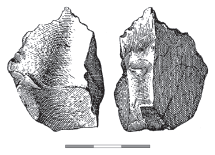
Fig. 32. Pointed scraper from a flake resembling a borer according to Steinmann. Flint, Upper Oligocene, Boncelles, Belgium. According to Steinmann “ . . . the two edges converging at the top [. . .] are marked with chippings being oriented almost exclusively to one side (A) [left figure]. Thus, the sample gains a certain similarity to a ‘borer-resembling pointed scraper’” (after Steinmann 1917, p. 90, fig. 20). One unit of scale bar = 1 cm (0.3 in).
The rule of the one-sided retouching of edges
With regard to the treatment of edgings, Verworn (1908, 1910b) drew attention to an important rule evident from the eoliths he had earlier observed in other stone cultures. It strongly hinted at the human origin of edge flakings. On tools being formed by one-sided treatment of the edges, chippings often run from the ventral (bulb surface) to the dorsal side of the detachment. The retouchings then are on the dorsal side. The reader has the opportunity to convince himself of the correctness of this rule with the help of the pictures in the specialist literature (for example, Adrian 1982). The famous German prehistorian Hahn (1991, p. 172) wrote, regarding scrapers from the Lower and Middle Paleolithic retouched on one side, that the retouching usually was made on the dorsal side, that is, starting from the ventral side. The early human had applied the one-sided retouching to the dorsal side because this was easier than on the smooth ventral side. The processed flint stones of Boncelles also show the one-sided retouching generally on the dorsal side as a rule.
Oligocene tools contradict the evolution of man
Tools from the Upper Oligocene could not, and still cannot, be integrated into existing concepts of the evolution of man. Those who are committed to those concepts are forced to consider tools like the ones from Boncelles as geofacts. By way of example, two authors from more recent literature, long after the discussion about eoliths, shall be given their say. Langbein (1976, p. 11) pointed out that at the end of the nineteenth century indigenous peoples such as the Tasmanian and Australian Aborigines lived in a true “eolithic tool stage,” and that in the Upper Pleistocene loess near Mons in Belgium flint flakes looking like eoliths were found (in the terminology of Rutot: Flénusien), which can only be explained by human activity. Langbein (1976, p. 11) continued:
Thus, it was verified that stones shaped like eoliths could have been formed by man . . . Transferring these recent industries to the questionable Tertiary find sites of Boncelles, Clermont and others turned into a disastrous shot into emptiness. Research on eoliths got lost beyond all bounds of space and time. . . . . All samples worth considering older than Miocene are to be dropped right from the beginning. Only later epochs are to be considered as being suitable for finding true stone relicts of the early human. Due to African australopithecine findings and other compelling reasons especially the border between Pliocene and Pleistocene was emphasized by the scientific interest. Only within these anthropologically secured periods of time as well as in the Pliocene the search for true tools is most promising. The decisive error of the past was that just this real factor of time had been totally ignored.
And recently the Dutch researcher van der Drift (2010, pp. 95, 97) wrote:
These eoliths were collected by the famous geologist Aimé Rutot in a period when it was yet unclear when the first hominids had evolved. Nowadays fossils and DNA prove that the hominid lineage is far younger than the Oligocene layers from which the “Fagnien” eoliths have been collected. The certainty that the “Fagnien” cannot contain artifacts . . . the context of the Oligocene deposits conclusively proves that the “Fagnien” cannot be of hominid provenance.
While Langbein and other researchers admit that Tertiary findings like the ones from Boncelles resemble specific stone tools of younger periods, the renowned German prehistorian G. H. R. von Koenigswald (1963, p. 140) wrote with regard to the findings of Boncelles by ignoring their actually existing features:
During a time which is long ago and had clear romantic aspects Rutot felt comfortable about allocating Oligocene flint stones being slightly indented along their edges to a special culture, the Fagnien.
In contrast, in the same publication he recognizes the rather crude African devices made from pebbles (fig. 33) as being unquestionably true tools, which indeed they are. Did von Koenigswald ever see the tool findings from Boncelles?
Tools from the Upper Paleocene in Northern France
Shortly after Rutot reported on the spectacular stone tool findings from the Oligocene of Boncelles (Belgium) in 1907, further tool-like flint findings from even older sediments were discovered and were reported by Commont (1909) and Breuil (1910).
For three years the well-known French prehistorian Henri Breuil repeatedly examined shattered flint stones in an Eocene pebble horizon (today allocated to the Paleocene) of Belle-Assise (sand pit Gervais) near Clermont in the Department Oise. The find site measured about 40 m2 (430 ft2) (Breuil 1910, p. 385). Commont (1909) also performed excavation campaigns in Belle-Assise, as well as in similar pebble layers in Lihus near Crèvecoeur (Oise) and in Ercheu (Somme) (the three sites are located in northern France, see fig. 1). He also discovered flint stones with tool-like features as they are known from the Paleolithic.
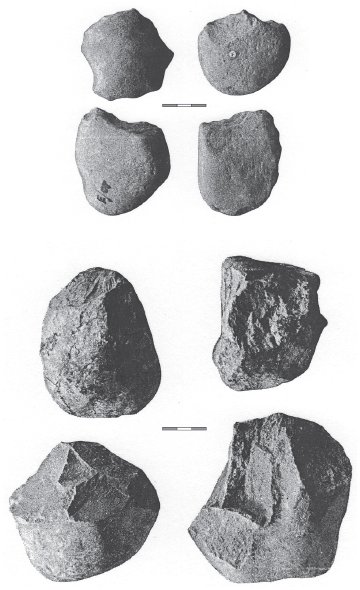
Fig. 33. Top: Pebble-tools from the Kafuan culture according to von Koenigswald with traces resulting from flaking and usage. Quartzite, Kasenga near Elizabethville, Katanga, Congo. Bottom: Pebble-tools from the Oldowan culture with two-sided flakings according to von Koenigswald. Basalt, Bed I of the Olduvai Gorge, Tanzania. Collection of von Koenigswald (after von Koenigswald 1963, p. 147, fig. 3). One unit of scale bar = 1 cm (0.3 in).
Geological situation
The flint stones are embedded in several layers of sand and clay which cover the Upper Cretaceous of the Paris Basin (fig. 34). Above (in the roof rock) is the grey and greenish sand of Bracheux (Breuil 1910, pp. 385–386; Commont 1909, pp. 467, 469–470). After the retreat of the Upper Cretaceous sea, firstly the Upper Cretaceous limestone (chalk) was dissolved, leaving behind its resistant flint stones. The sediments that followed are regarded as a transgressive sequence. That is, after a temporary retreat the sea returned to the Paris Basin, leading to the relocation of the flint stones that had been left behind, and to them becoming embedded in the lowest layers of the transgressive sequence. The sea then deposited several meters of sands on top of the flintstone-bearing layers, which are named the “Sables de Bracheux” (see fig. 34 again). Right at the beginning of the twentieth century these were, due to their contained index fossils, allocated to the Thanetian stage of the Lower Eocene. Later geologists moved the boundary between the Eocene and Paleocene upward (see fig. 5). Thus, the “Sables de Bracheux” now belong to the Paleocene, the earliest epoch of the Tertiary (Krömmelbein and Strauch 1991; Pomerol 1982, pp. 58, 61–62; cf. Stephan 2002, p. 182). The age of the Thanetian is now stated as 56.0 to 59.2 million isotope years (Gradstein et al. 2012).
The geological situation in the Paris Basin is similar to the conditions at the edge of the northern Ardennes. As stated earlier, in the area of Belle-Assise near Clermont there also were flint stones left behind from dissolution of the underlying Upper Cretaceous limestone. They could have been picked up by humans from the land surface which had dried up and could have then been processed. However, the Tertiary sea returned to the Paris Basin earlier than it did to the Ardennes, and therefore covered the flintstone-bearing layers and the Bracheux sands as early as the Upper Paleocene (Stephan 2002, p. 182).
The flint stones found by H. Breuil and V. Commont at several locations in northern France show distinct indices of human processing. Rutot (1907) had already considered the Oligocene stone tools of Boncelles to be a major problem. Having double the isotope age these new tool findings were, and still are, a sensation which stands in even sharper conflict with theoretical evolutionary ideas. In the following section the artifact features of these findings will be discussed in detail.
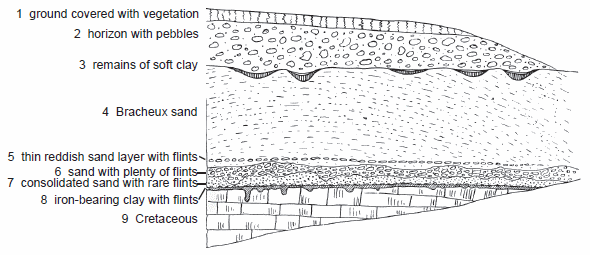
Fig. 34. Geologic section through the deposit in Belle-Assise. Total thickness 8–10 m (26–32 ft) (after Breuil 1910, p. 386).
The tools
Breuil found without any doubt numerous flint stones bearing flake scars and retouchings similar to those found on well-known eoliths and artifacts from the Paleolithic in Belle-Assise.
Breuil invited several prehistorians to certify the findings in their location. Capitan, Cartailhac and Obermaier collected further characteristic flint stones in the presence of Breuil (1910, p. 386). Among the flint stones Breuil discovered many examples with percussion bulbs, numerous samples even with retouching of the edges, partially in a very good shape. Obermaier (1912, p. 400) referred to the illustration of a human detachment from a publication by Verworn. The illustration presents the typical features of such a detachment which are still valid today (cf. for example, Debénath and Dibble 1994, pp. 12–13 and fig. 8; Feustel 1985, pp. 28–29; Schick and Toth 1993, pp. 93–94). Obermaier pointed out that these characteristics are obviously also observable on the Belle-Assise material (Obermaier 1912, p. 400). Fig. 35 presents a selection of typical examples with artifact features from this location.
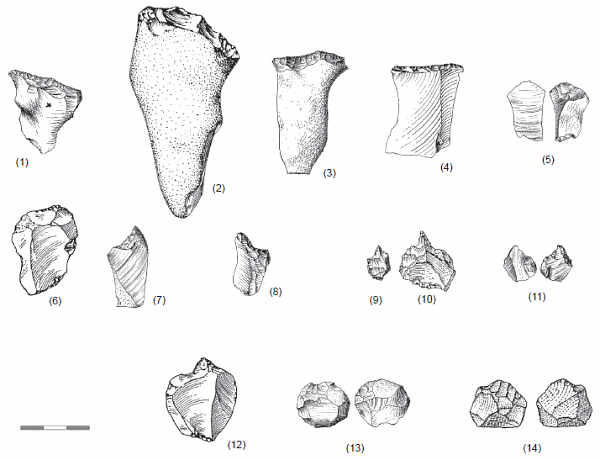
Fig. 35. (1), (3), (5), (7), (9), (11), (13) Flint findings from a Paleocene layer in Belle-Assise (Oise) in France. Many findings, according to Breuil, show typical artifact features. Breuil compared them to the tools from the Paleolithic (chisels, scrapers, tips, drills amongst others,) but he still called them “pseudo-eoliths” being formed by geological pressures. Up to now there is no proof, and it is most unlikely from a theoretical point of view that such tool-like flint stones, let alone their occurrence in large numbers in one location, were formed by incidental geological pressures (after Breuil, 1910, pp. 392, 394, 396, 401, figs. 21, 24, 41, 57, 60, 65, 66). (2) Chopper-like tool from a long nodule, according to Adrian. Flint, Paleolithic, Borgholzhausen-Cleve, district of Gütersloh, Germany (after Adrian 1982, pl. 99, 13.586). (4) Scraper from a cortex-flake, according to Adrian. Flint, Paleolithic, Stukenbrock-W, district of Gütersloh, Germany (after Adrian 1982, pl. 182, Be-252). (6) Scraper according to M. D. Leakey. Chert, Lower Paleolithic, Olduvai Gorge, Tanzania (after M. D. Leakey 1971, p. 103, fig. 53.14). (8) Inclined scraper from a small blade, according to Adrian. Flint, Paleolithic, Borgholzhausen-Cleve, district of Gütersloh, Germany (after Adrian 1982, pl. 141, 10.393). (10) Precision borer, according to Mania. Flint, Lower Paleolithic, Bilzingsleben, Thuringia, Germany (after Mania 1997, p. 147, fig. 96.17). (12) Awl, according to M. D. Leakey. Chert, Lower Paleolithic, Olduvai Gorge, Tanzania (after M. D. Leakey 1971, p. 103, fig. 53.14, © Cambridge University Press 1971, reproduced with permission). (14) Discoid, according to Fiedler. Quartzite, Lower Paleolithic, Münzenberg, Germany (after Fiedler 1997b, p. 67, fig. 32.2). One unit of scale bar = 1 cm (0.3 in).
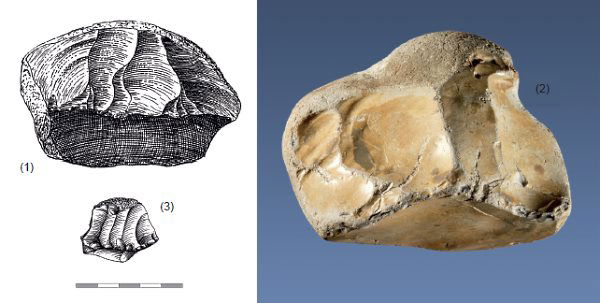
Fig. 36. (1) Flint core according to Commont from a Paleocene layer in Ercheu (Somme), France (after Commont 1909, p. 471, fig. 3). (2) Core, flint, Lower Paleolithic, Wimereux, Pas-de-Calais, France. (Photograph: Michael Gleim). (3) Broad and bulky core according to Adrian. Flint, Paleolithic, Borgholzhausen-Cleve, district of Gütersloh, Germany (after Adrian 1982, pl. 153, 14.564). One unit of scale bar = 1 cm (0.3 in).
Breuil mentioned one feature of the flakes from Belle-Assise which can hardly be overestimated in its relevance. The retouchings are, as it is the case with the other Tertiary stone tools and detachment appliances from the Paleolithic, mainly situated on the opposite side to the percussion bulbs, that is, on the dorsal side. However, Breuil did not attribute this feature to humans, but to physical forces (Breuil 1910, p. 408). In his explanation he does not state any plausible physical, that is, accidental reasons for their origin, which he still considered true. Yet this is implausible. It is the retouchings of the edges of the detachments of the Belle-Assise stones which are mainly situated on their dorsal sides that practically verifies their origin as human artifacts.
Commont (1909) also described and illustrated several Eocene (today Paleocene) objects from the Bracheux Sands (located at Lihus and Ercheu). They showed typical features of human detachments and processing, and thus resemble typical Paleolithic artifacts (cores, pounders, scrapers, knives, piercers) as do the Belle-Assise findings. Fig. 36 shows a core with several parallel scars from typical detachments made by humans. Fig. 37 shows several scrapers.
Breuil let the Belgian geologist and prehistorian Rutot have his findings for assessment without indicating their origin. Commont also presented his findings to competent prehistorians without stating their origin. Without exception they recognized the findings as flint stones that once were processed by humans (Breuil 1910, pp. 405–406; Commont 1909, p. 468; Rutot 1911, pp. 12–15). Since the findings were too old with regard to their theoretical evolutionary context, they “had to” have been formed naturally. They must have been formed by natural pressures, Breuil (1910) and Commont (1909) stated, followed by many other researchers. It has already been argued that incidental pressures are unlikely to modify masses of stones into tool-like shapes.
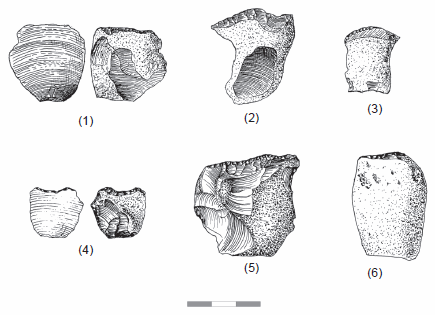
Fig. 37. (1)–(3) Flint endscraper with delicate retouchings according to Commont from a Paleocene layer in Lihus (Oise), France (after Commont 1909, p. 477, fig. 8.1–8.3). (4) Small scraper with concave working edge, according to Adrian. Flint, Paleolithic, Borgholzhausen-Holtfeld, district of Gütersloh, Germany (after Adrian 1982, pl. 71, 11.816). (5) Broad scraper with alongside tip, according to Adrian. Flint, Paleolithic, Stukenbrock-FW, district of Gütersloh, Germany (after Adrian 1982, pl. 265, 14.583). (6) Endscraper from a cortex flake, according to Adrian. Flint, Paleolithic, Stukenbrock-W, district of Gütersloh, Germany (after Adrian 1982, pl. 181, Bd-406). One unit of scale bar = 1 cm (0.3 in).
It is possible that Breuil’s findings from Belle-Assise near Clermont (Oise) were of heterogeneous origin. Among them there were flakes still partially attached to the source rocks. They might have been formed by geological pressures, but an anthropogene origin could still not have been excluded. In contrast, the samples wrongly named “pseudoeoliths” by Breuil showed distinct artifact features, and they were found detached from their source rocks. Contrary to Breuil’s statement, formation by accidental pressures did not apply to them (see the extensive discussion in Brandt 2011a; Cremo and Thompson 2005).
Rapid spread of the “news” of Belle-Assise
Breuil’s article provoked much excitement. The opponents of the anthropogene origin of eoliths accepted his pressure hypothesis at once, without critical questioning. The British geologist Sollas serves as an example.
An amendment was added to the first edition of his book Ancient Hunters (Sollas 1911) while still in print. In it he wrote about the formation of the eoliths found by Henri Breuil in the sands of the Lower Eocene (Thanétien, today Upper Paleocene) in Belle-Assise, Clermont (Oise):
M. Breuil shows in the most convincing manner that they all owe their formation to one and the same process, that is, to movements of the strata while settling under pressure of the soil. The flint nodules crowded together in a single layer are thus squeezed forcibly one against the other, and flaking is the inevitable result. (Sollas 1911, p. 68)
However, it needs to be acknowledged that in the third edition of Ancient Hunters, Sollas (1924, pp. 96, 102, 104) accepted the Tertiary stone tools from the Upper Miocene of Aurillac in France, and from the Pliocene at Ipswich in Britain for the first time, due to their distinct tool character. However, even for Sollas (like for many other researchers) the last deciding instance for the assessment of possible Tertiary tool findings is not the artifact character, but the question of whether the existence of tool-making creatures fits into a theoretical evolutionary concept.
Uncertainty of the supporters of the tool nature of eoliths
It is an important fact that not only the opponents of the artifact nature of eoliths, but also the supporters, were adherents of the evolutionary theory. Since the newly-found stone tools from the early Tertiary were not able to be integrated into an evolutionary perception they were, despite their obvious artifact nature as human relicts, also not accepted by prehistorians, who only recognized tool findings from late Tertiary strata (Pliocene, Upper Miocene). The Belle-Assise findings led to a serious uncertainty among this group of researchers, for it seemed that the opponents of the human origin of eoliths had finally found the evidence for the statement they had repeated for decades, that natural processes were able to modify stones in great numbers so that they were indiscernible from real tools. Rutot was puzzled when he learnt about the Eocene (today Paleocene) origin of the Belle-Assise flint stones he had formerly regarded as artifacts (Breuil 1910, p. 406; Rutot 1911, pp. 12–15). Due to their early stratigraphic classification Rutot fully accepted Breuil’s pressure hypothesis as the natural cause of the origin of those findings, despite their definite artifact nature (Rutot 1911, p 15): “Since the flint stones from Belle-Assise are indisputably of Lower Eocene age . . . . I fully agree to Breuil’s conclusions . . . .”
In his later comprehensive work La Préhistoire, published in 1918, Rutot describes the Boncelles tools, but does not mention the Belle-Assise findings.
The early Tertiary artifactoid flint-stone findings from northern France were a severe blow to the group of researchers supporting the human origin of eoliths for the reasons mentioned above. The discussion then quickly changed in favor of the opponents.
Misinterpretation of Pithecanthropus Changes Discussion
Rapid establishment of the Java man as a “missing link”
Until the end of the nineteenth century the Neanderthal was the only candidate for an evolutionary ancestor of modern humankind. In spite of all the disagreement in the interpretation though (Auffermann and Orschiedt 2002; Tattersall 1995), he was regarded too human to be an ape-like ancestor of man (Huxley 1863, pp. 181–182; Shipman and Storm 2002, p. 110).
In 1891 the Dutch physician Eugène Dubois discovered human relicts in Java, in particular a calvarium and a femur which he allocated to one person. Dubois declared he had found a link between ape and man (Dubois 1894). Several articles and books about Pithecanthropus were published by different scientists. The presentations ranged from Dubois’s view as an ape-man (Shipman and Storm 2002, pp. 113–114), to the status of an ape but more highly developed than modern great apes (Obermaier 1912, pp. 371–372), or to the status of man but definitely primitive (“man of dawn”) (Osborn 1927, p. 72). None of the authors, however, denied his great relevance to the question about the origin of man, and his established place in the evolutionary genealogical tree far from modern man. The Java man was unanimously classified as rather primitive. How old was the finding?
Dubois had assumed that Pithecanthropus erectus lived at the end of the Tertiary (Osborn 1927, p. 73). Soon this assumption was revised and he was allocated to the Pleistocene, according to Obermaier (1912, p. 374) most likely to the Middle Pleistocene. Today an age of about one million isotope years is attributed to the Java man (Henke and Rothe 1994, pp. 392–393).
Effects on the discussion about eoliths
The age of the newly found “missing link” had a major effect on the discussion about eoliths, because it marked the time horizon in which, according to the scientific community searching within the evolutionary context, the transition from the great ape to the human took place, and thus limited the chance for discovering earlier possible hints to the existence of humans in earth history. Prior to the discovery of Pithecanthropus there was less obligation regarding this question. Thus, Huxley wondered (1863, p. 184):
Where, then, must we look for primaeval Man? Was the oldest Homo sapiens Pliocene or Miocene, or yet more ancient? In still older strata do the fossilized bones of an Ape more anthropoid, or a Man more pithecoid, than any yet known await the researches of some unborn paleontologist?
With the discovery of Pithecanthropus the situation changed fundamentally. Thus, the opponent of the tool nature of eoliths, Paul Sarasin, voiced (1908, p. 213):
. . . finally the circumstance that a form was found, Pithecanthropus, which obviously combines somatic, special cerebral conditions of Holocene and Pleistocene lower human varieties or species with those of anthropoid apes makes the animal origin of the genus Homo look to have moved closer toward present time than the age of the eoliths in case they were artifacts would allow this.
Some years after the discovery of Pithecanthropus a bone was found in Germany which was attributed to another pithecanthropoid creature (Homo heidelbergensis), the lower jaw being found at Mauer in 1907 near Heidelberg (Schoetensack 1908). Werth examined the Heidelberg man in detail and declared in his essay Der tertiäre Mensch (die Eolithen- und die Vormenschenfrage) (that is, The Tertiary man: The Question about Eoliths and Pre-men) to have found a distinct similarity to the gibbon (Werth 1918). He introduced this new finding next to Pithecanthropus into the discussion about the eoliths, where the articulateness of his statements is crystal clear. Therefore his comments stated in the following are extremely informative (Werth 1918, p. 19, emphasis is taken from the original):
. . . so we—when looking back in chronology—finally arrived (in terms of time) with the Middle Pleistocene Homo heidelbergensis at the border of humankind. Pithecanthropus erectus taught us the same although his geological age is even more disputed and less ensured. Therefore it must appear hopeless to look for a true human in Tertiary. . . . we do not only not know a true human, an entire human (a species of the gender Homo) from the Tertiary; no, we do not even have to expect such a species. . . . There is no Tertiary man, L’homme tertiaire n’existe pas!
Werth’s assessment clearly reveals why Tertiary (and early Quaternary) stone tools “needed to” be removed from the discussion about the origin of man: They did not fit into the existing ideas about evolution.
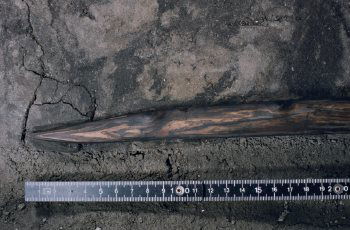
Fig. 38. Spear from the Lower Paleolithic, district of Helmstedt, Germany, showing the detail of the carefully shaped tip of spear II (total length about 2.30 m [7.5 ft]). Spears from the Lower Paleolithic of Schöningen are high performance spears suited for any distance. Each spear has been optimally formed. The head is made from the hardest part of the tree at the base. Each spear has the same proportions as a modern spear with maximal thickness and heaviest weight (center of gravity) in the front part. The long hind part is tapering toward the end. To manufacture the spears intense planning, an exacting draft and patience while carving the wood were required. It is obvious that the European early humans had capabilities which so far were believed to be the capabilities of modern man. © Dr. Hartmut Thieme, Niedersächsisches Landesamt für Denkmalpflege, Hannover. (Photograph: C.S. Fuchs).
Today’s position of Pithecanthropus and Heidelberg man
Pithecanthropus erectus who is allocated to Homo erectus today and the Heidelberg man have been regarded as true humans by prehistorians for some time. Yet, in comparison to modern man these early humans are still presented as primitive-minded creatures. The latest findings have shown that this view is wrong.
Hartmut Thieme (1997), however, retrieved in Schöningen, Germany, optimally-manufactured high-performance spears (fig. 38), which have been estimated to be ca. 400,000 (Thieme 1997) or 310,000 isotope years old (Jöris and Baales 2003, p. 286). Dennell (1997, p. 768) stated in his accompanying commentary in Nature on these spears found by Thieme:
. . . we see considerable depth of planning, sophistication of design, and patience in carving the wood, all of which have been attributed only to modern humans.
Further surprising results supporting the concept of a mentally highly developed early human are hints in the form of stone tools pointing to repeated ocean crossings (populating of islands) by Homo erectus about one million radiometric years ago in the Indonesian archipelago (Brumm et al. 2010; see Morwood et al. 1998) and the discovery of a moon calendar in Bilzingsleben, Germany (fig. 39) (Schößler 2003), in the possession of Homo erectus being estimated to an age of ca. 400,000 isotope years (Mania 1998, pp. 55, 60–61). The mental capability of the early humans was therefore comparable to that of the modern Homo sapiens. So the denial of Tertiary humans was based on a wrong estimation of the abilities of the early humans.
In the evolutionary model the australopithecines has taken over the position of Homo erectus and the Heidelberg man as “pre-human” since the middle of the twentieth century. The status of these “ape-men” and severe problems with the construction of a lineage between these “pre-humans” and the true humans within the evolutionary concept cannot be discussed in detail here. However, it should be pointed out that it is more plausible to interpret these creatures with regard to creation as apes without any relationship to the human and to the recent apes instead of evolution.
No Relicts of Human Bodies—An Argument against the Existence of Humans in the Tertiary?
This paper is not about reports of findings of relicts of human bodies in the Tertiary (cf. however, Cremo and Thompson 2005), since the author does not consider himself to be in a position to check their plausibility. It might be possible that those reports are not reliable. Are stone tools alone sufficient for the assumption that humans existed when the Tertiary strata were being deposited, or is there a need for additional findings of human bones?
If it is likely that artifactoid stones in great numbers could be formed by natural processes in one location (that with an equally clear situation as in the Tertiary locations), then tool-like stones would not be sufficient to hint at the existence of humans. However, this is not the case. In the following it will be shown that with the accordingly clear situation of the evidence (the collections of stones with artifact features) the absence of human bone relicts is not regarded as a hindrance to concluding that man existed. In some cases body relicts were found decades after the stone relicts of humans had been found, as for example, in Olorgesailie in Kenya after 61 years of research (Potts et al. 2004, pp. 75–76). In several renowned Quaternary locations with stone tools no relicts of bodies have been found until today.
In 2005 Nature published a report on the discovery of 32 stone artifacts in the Cromer Forest Bed by Simon A. Parfitt and colleagues (Parfitt et al. 2005). The findings are stated to be 700,000 isotope years old. The ground opening of Pleistocene sediments is situated at a cliff line near Pakefield (Suffolk, East Anglia) (see fig. 1). The tools were retrieved from four different locations from sediments being deposited onshore as well as from river sediments located further inland. So they do not stem from an original context, but from another, to a greater or lesser extent, re-sedimented archeological one (Parfitt et al. 2005, p. 1008). In the accompanying commentary to the findings in the Cromer Forest Bed the renowned Dutch prehistorian Wil Roebroeks (2005) emphasized that this finding would change the view of prehistorians on the history of the population of Europe. Up to that time the archeological doctrine prevailed that the population of northern Europe would not be older than 500,000 isotope years. Thirty-two flint artifacts from relocated strata (!), and thus rather scarce evidence, were enough to promptly end a high-ranking controversy lasting for years.
An even more impressive example comes from the location Dorn-Dürkheim 3 (Rhenish Hesse, Germany) (Fiedler 2003). Regardless of the eolith discussion, and even prior to the Nature publication, these findings pointed to a population of northern Europe earlier than 500,000 radiometric years ago.
During a paleontological excavation, among other finds 250 molar teeth of the bush elephant were retrieved from sediments dated radiometrically to 800,000 years. Franzen explained this accumulation as having been caused by humans. A discovered polyhedric stone verified this assumption. Since no further artifactoid samples could be found, for the time being the polyhedron was laid aside as an unusual natural product. Franzen then explained the paleontological record to be caused by nature (Franzen 1999). A reinvestigation of the stones retrieved during the excavation by Lutz Fiedler finally showed that the quartzite polyhedron is an artifact without any doubt. According to Fiedler the complex shaping process excludes a natural formation. Additionally, two more findings from the excavation could be identified as artifacts—a scraper made from a quartzite flake, and a little drill made from a quartz flake (Fiedler 2003).
The stone tools from Dorn-Dürkheim are casual findings. They are single findings retrieved from a small area which do not show any recognizable archaeological connection. In spite of these circumstances and the fact that they come from a time in which, according to the conventional archeological doctrine, there were no humans living in Germany, these three findings (the polyhedron on its own might have been sufficient!) led to the conclusion that the presence of humans was verified.
Since there are only a few Tertiary locations, the absence of evidence of human relicts from this time is not unusual, compared to the Pleistocene where a lot more stone tools have been found.
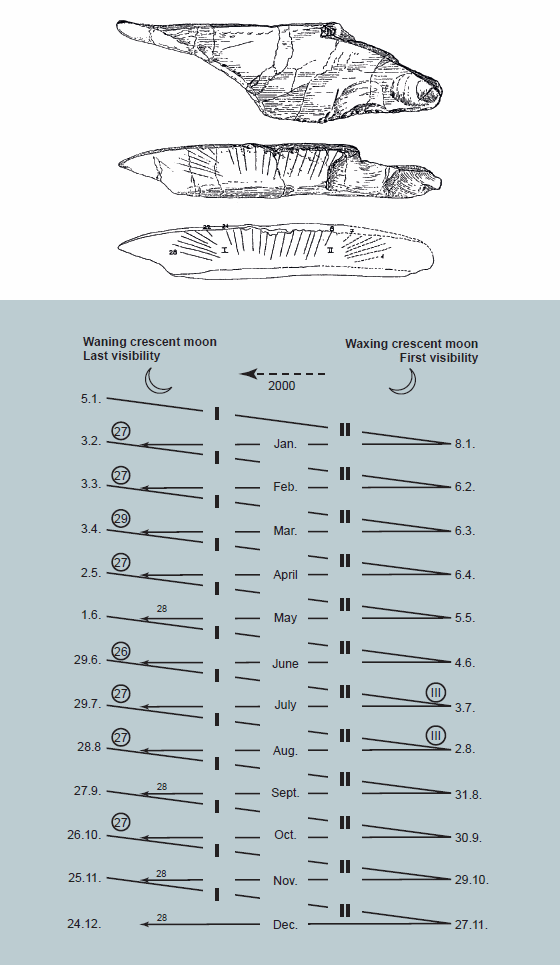
Fig. 39. Bone fragment from the Lower Paleolithic showing an engraved stroke sequence, from Bilzingsleben, Thuringia, Germany (after Schößler 2003, pp. 30–31, fig. 1, table 1). The finding consists of a broken part of the tibia of a forest elephant bearing a fan of stroke bundles (dotted lines have been added). According to Schößler it might represent a moon calendar. The manufacturer of the calendar was a Homo erectus.
Consequences
Large periods of time are unlikely
The tool findings from the Tertiary of Europe do not only question all ideas of a human descent from animal ancestors, they also contradict the established geological concept of large time epochs.
The mysterious absence of an evolution of eoliths for many millions of years has been made into an argument against the human origin of these findings. Obermaier (1908, pp. 303–304) put it like this:
Nonetheless the generally emphasized “human” cultural level of the Oligocene and Miocene “industries” as well as the fact that the shaping of eoliths remains absolutely the same through all stages and has not the least been improved during innumerable centuries are an argument against it [the existence of man]. This contradicts any law of evolution which should be reflected not only somatically but also intellectually.
And Penck (1908, p. 405) wrote:
. . . a stagnation in the development of manufacts would also be striking. The eoliths from Boncelles resemble . . . those from Cantal and those from the Early Quaternary. For millions of years the same types occur and only then further development takes place.
And this is, in fact, a mysterious feature. For even in the conventional history of humankind of about two million years it is baffling why the population did not grow, why there are only relatively few human relicts, and why the cultural-technical development in this vast period essentially stagnated (Brandt 2011b). By providing evidence of human relicts in the Tertiary these problems grow considerably. They pose a large challenge to the conventional large periods of time. Stone tools in the Tertiary point to a duration of this geological period of only hundreds, and not millions, of years.
Animal ancestors of man unknown—man created
These distinctive hints of the presence of true humans even in the early Tertiary of Europe quite strikingly contradict the leading evolutionary ideas of today’s prehistorians. According to the commonly held views of evolutionary theory, Hominoidea (apes) derived from the Old World monkeys (Cercopithecoidea) about 25 to 30 million isotope years ago (Stevens et al. 2013, p. 611). The currently discussed ancestors of the primates are dated to about 56 million isotope years, and the separation of the primates from the other Euarchonta is estimated to have happened 65 million isotope years ago at the earliest (Bloch et al. 2007). Yet, even tool findings from “just” the late Tertiary do not fit into today’s general ideas of evolution. They point to another account of the early history of humankind than that presented in the evolutionary model of origins. Stone tools in the early Tertiary support the hypothesis according to which both the fossil forms of true humans and recent humans belong to a basic type which was created.
Acknowledgments
The author wishes to thank Ms. Isa Sefzick for translating the text from German to English. Special thanks are due to Dr. Andrew Snelling for his helpful advice, corrections and improvements of the English text.
References
Abbott, W. J. L. 1905. Machine-made eoliths. Man 5:146–148.
Adrian, W. 1982. Die Altsteinzeit in Ostwestfalen und Lippe. Köln, Wien, Germany: Böhlau Verlag.
Auffermann, B. and J. Orschiedt. 2002. Die Neandertaler: Eine spurensuche. Stuttgart, Germany: Konrad Theiss Verlag.
Barnes, A. S. and J. R. Moir. 1923. A criticism of Mr. S. Hazzledine Warren’s views on eoliths. Man 23:51–55.
Bennett, F. J. 1906. Machine-made implements. The Geological Magazine 3:69–72.
Bloch, J., M. T. Silcox, D. M. Boyer, and E. J. Sargis. 2007. New Paleocene skeletons and the relationship of plesiadapiforms to crown-clade primates. Proceedings of the National Academy of Sciences 104:1159–1164.
Boule, M. 1905. L’origine des éolithes. L’anthropologie 16:257–267.
Bourgeois, L. 1868. Étude sur des silex travaillé trouvés dans les dépôts tertiaires de la commune de Thenay, près Pontlevoy (Loir-et-Cher). In Congrès international d’anthropologie et d’archéologie préhistoriques, Paris 1867, Compte Rendu, pp. 67–75.
Bourgeois, L. 1877. La question de l’homme tertiaire. Revue des questions scientifiques 2:561–575.
Brandt, M. 2011a. Vergessene archäologie: Steinwerkzeuge fast so alt wie dinosaurier. Holzgerlingen, Germany: Hänssler-Verlag.
Brandt, M. 2011b. Wie alt ist die menschheit? Demografie und steinwerkzeuge mit überraschenden befunden, 4th ed. Holzgerlingen, Germany: Hänssler-Verlag.
Breuil, H. 1910. Sur la présence d’éolithes à la base de l’Éocène Parisien. L’anthropologie 21:385–408.
Breuil, H. and R. Lantier. 1965. The men of the Old Stone Age, 2nd ed. London, United Kingdom: George G. Harrap & Co.
Brousse, R., E. Heintz, F. Park, and H. Bellon. 1975. Gisement, faune et géochronologie du Puy Courny (Cantal, France). Géologie Méditeranéenne 2:135–142.
Brumm, A., G. M. Jensen, G. D. van den Bergh, M. J. Morwood, I. Kurnniawan, F. Aziz, and M. Storey. 2010. Hominins on Flores, Indonesia, by one million years ago. Nature 464:748–752.
Carter, G. F. 1980. Earlier than you think: A personal view of man in America. College Station, Texas: Texas A&M University Press.
Clark, J. D. 1958. The natural fracture of pebbles from the Batoka Gorge, Northern Rhodesia, and its bearing on the Kafuan industries of Africa. Proceedings of the Prehistoric Society 24:64–77.
Commont, V. 1909. A propos d’éolithes. Silex présentant les apparences de à taille intentionnelle a la base de l’Éocène. Annales de la Société Géologique du Nord 38:462–480.
Cremo, M. A. and R. L. Thompson. 1994. Verbotene archäologie. Essen, München, Germany: Bettendorf.
Cremo, M. A. and R. L. Thompson. 2005. Forbidden archeology, 12th ed. Los Angeles, California: Bhaktivedanta Book Publishing.
Debénath, A. and H. L. Dibble. 1994. Handbook of Paleolithic typology. Vol. 1. Lower and Middle Paleolithic of Europe. Philadelphia, Pennsylvania: University Museum, University of Pennsylvania.
de Bont, R. 2003. The creation of prehistoric man. Isis 94:604–630.
de Mortillet, G. 1883. Le préhistorique. Paris, France: C. Reinwald.
de Mortillet, G. and A. de Mortillet. 1881. Musée préhistorique. Paris, France: C. Reinwald.
de Mortillet, G. and A. de Mortillet. 1900. Le préhistorique. 3rd ed. Paris, France: C. Reinwald.
Dennell, R. 1997. The world’s oldest spears. Nature 385:767–768.
de Quatrefages, A. 1887. Histoire générale des races humaines. Paris, France: A. Hennuyer.
Dubois, E. 1894. Pithecanthropus erectus, eine menschenaehnliche übergangsform aus Java. Batavia: Landesdruckerei.
Ernst, M. and G. Gerard. 2010. Die tertiäre fundschicht der Eolithen von Aurillac. Holzgerlingen, Germany: Hänssler-Verlag.
Feustel, R. 1972. Problematische primitivgeräte aus Tertiär und Pleistozän. Alt-Thüringen 12:7–30.
Feustel, R. 1985. Technik der steinzeit, 2nd ed. Weimar, Germany: Hermann Böhlaus Nachfolger.
Fiedler, L. 1997a. Die Suche nach den kulturellen anfangen. In Archäologie der ältesten kultur in Deutschland: Ein sammelband zum älteren Paläolithikum, der zeit des Homo erectus und des frühen Neandertalers, ed. L. Fiedler, pp. 1–4. Wiesbaden, Germany: Selbstverlag des Landesamtes für Denkmalpflege Hessen.
Fiedler, L. 1997b. Älteres Paläolithikum aus dem Gebiet zwischen Mittelrhein, Main und Werra. In Archäologie der ältesten kultur in Deutschland: Ein sammelband zum älteren Paläolithikum, der zeit des Homo erectus und des frühen Neandertalers, ed. L. Fiedler, pp. 49–79. Wiesbaden, Germany: Selbstverlag des Landesamtes für Denkmalpflege Hessen.
Fiedler, L. 2003. Nach Dmanisi, vor Tautavel: Altpaläolithikum in Mitteleuropa. In Erkenntnisjäger, ed. J. M. Burdukiewicz, L. Fiedler, A. Justus, and E. Brühl, pp. 193–198. Halle, Germany: Landesamt für Denkmalpflege und Archäologie Sachsen-Anhalt.
Franzen, J. L. 1999. Die Flut—der Rheinhessensee. Natur und Museum 129:201–212.
Gradstein, F. M., J. G. Ogg, M. D. Smith, and G. M. Ogg, eds. 2012. Geologic time scale 2012. Amsterdam, Netherlands: Elsevier.
Grayson, D. K. 1986. Eoliths, archeological ambiguity, and the generation of “middle-range” research. In American archaeology past and future, ed. D. J. Meltzer, D. D. Fowler, and J. A. Sabloff, pp. 77–133. Washington, London: Smithsonian Institution Press.
Hahn, J. 1991. Erkennen und bestimmen von stein und knochenartefakten: Einführung in die artefaktmorphologie. Tübingen, Germany: Institut für Ur- und Frühgeschichte der Universität Tübingen.
Hahne, H. 1905. Die beziehungen der kreidemühlen zur Eolithenfrage. Zeitschrift für Ethnologie 37:1024–1035.
Heizmann, E. P. J., W. Munk, A. Ziems, R. L. Bernor, and H. König. 2003. Neue grabungen am Höwenegg (Gemeinde Immendingen, Landkreis Tuttlingen, Baden-Württemberg). Carolinea 61:5–16.
Henke, W. and H. Rothe 1994. Paläoanthropologie. Heidelberg, Germany: Springer-Verlag.
Hinton, A. C. 1905. Discussion of “On the origin of ‘eolithic’ flints by natural causes, especially by the foundering of drifts” by S. H. Warren. Journal of the Anthropological Institute 35:337–364.
Hosfield, R., J. Chambers, and P. Toms. 2007. The archaeological potential of secondary contexts [data-set]. York: Archaeology Data Service [distributor] (doi:10.5284/1000291). Retrieved from http://archaeologydataservice.ac.uk/archives/view/apscontexts_eh_2007/index.cfm on February 2, 2013.
Huxley, T. H. 1863. Evidence as to man’s place in nature. New York, New York: D. Appleton and Company.
Jöris, O. and M. Baales. 2003. Zur altersstellung der Schöninger speere. In Erkenntnisjäger, ed. J. M. Burdukiewicz, L. Fiedler, W.-D. Heinrich, H. Justus, and E. Brühl, pp. 281–288. Halle, Germany: Landesamt für Denkmalpflege und Archäologie Sachsen-Anhalt.
Kendall, H. G. O. 1905. Discussion of “On the origin of ‘eolithic’ flints by natural causes, especially by the foundering of drifts” by S. H. Warren. Journal of the Anthropological Institute 35:337–364.
Kennard, A. S. 1921. Discussion of “A natural ‘eolith’ factory beneath the Thanet Sand” by S. H. Warren. Quarterly Journal of the Geological Society of London 76:238–253.
Krömmelbein, K. and F. Strauch. 1991. Historische geologie: Erd- und lebensgeschichte. Brinkmanns abriß der geologie, vol. 2, 14th ed. Stuttgart, Germany: Ferdinand Enke Verlag.
Langbein, W.-D. 1976. Die Brenztalkultur: Geologisches alter und archäologische bedeutung. Frankfurt, Germany: Peter Lang.
Leakey, M. D. 1971. Olduvai Gorge. vol. 3: Excavations in Bed I and II, 1960–1963. Cambridge, United Kingdom: Cambridge University Press.
Lohest, M., P. Fourmarier, J. Hamal-Nandrin, C. Fraipont, and L. Capitan. 1923. Les silex d’Ipswich. Conclusions de l’enquête de l’institut international d’anthropologie. Revue anthropologique 33:44–67.
Luedtke, B. E. 1986. An experiment in natural fracture. Lithic Technology 15:55–60.
Mahoudeau, P.-G. and L. Capitan. 1901. La question de l’homme Tertiaire à Thenay. Revue de l’ecole d’anthropologie 11:129–153.
Mania, D. 1997. Altpaläolithikum und frühes Mittelpaläolithikum im Elbe-Saale-gebiet. In Archäologie der ältesten kultur in Deutschland: Ein sammelband zum älteren Paläolithikum, der zeit des Homo erectus und des frühen Neandertalers, ed. L. Fiedler, pp. 86–194. Wiesbaden, Germany: Selbstverlag des Landesamtes für Denkmalpflege Hessen.
Mania, D. 1998. Die ersten menschen in Europa. Stuttgart, Germany: Konrad Theiss Verlag.
Moir, J. R. and A. S. Barnes. 1923. A criticism of Mr. S. Hazzledine Warren’s views on eoliths. Man 23:119–121.
Morwood, M. J., P. B. O’Sullivan, F. Aziz, and A. Raza. 1998. Fission-track ages of stone tools and fossils on the east Indonesian island of Flores. Nature 392:173–176.
Noetling, F. 1911. Comparison of the Tasmanian Tronatta with the archaeolithic implements of Europe. In Papers and Proceedings of the Royal Society of Tasmania 1910, pp. 265–278. Hobart, Tasmania: The Society of Tasmania.
Oakley, K. P. 1972. Man the tool-maker, 6th ed. London, United Kingdom: British Museum (Natural History).
Obermaier, H. 1906. Zur eolithenfrage. Archiv für Anthropologie 4:75–86.
Obermaier, H. 1908. Das geologische alter des menschengeschlechts. Mitteilungen der Geologischen Gesellschaft in Wien 1:290–322.
Obermaier, H. 1912. Der mensch der vorzeit. Berlin, München, Wien, Germany: Verlagsgesellschaft.
Obermaier, H. 1925. Das eolithenproblem. In Reallexikon der Vorgeschichte, vol. 3: Ebenalphöhle-Franken, ed. M. Ebwert, pp. 99–107. Berlin. Germany: Verlag Walter de Gruyter & Co.
O’Connor, A. 2003. Geology, archaeology, and the ‘the raging vortex of the “eolith” controversy’. Proceedings of the Geologists’ Association 114:255–262.
Osborn, H. F. 1927. Man rises to Parnassus. Princeton, New Jersey: Princeton University Press.
Parfitt, S. A., R. W. Barendregt, M. Breda, I. Candy, M. J. Collins, G. Russell Coope, P. Durbidge, et al. 2005. The earliest record of human activity in northern Europe. Nature 438:1008–1012.
Patterson, L. W. 1983. Criteria for determining the attributes of man-made lithics. Journal of Field Archaeology 10:297–307 Retrieved from http://www.jstor.org/discover/10.2307/.
Patterson, L. W., L. V. Hoffman, R. M. Higginbotham, and R. D. Simpson. 1987. Analysis of lithic flakes at the Calico Site, California. Journal of Field Archaeology 14:91–106.
Penck, A. 1908. Das alter des menschengeschlechtes. Zeitschrift für Ethnologie 40:390–407.
Pomerol, C. 1982. The Cenozoic era. Chichester, United Kingdom: Ellis Horwood.
Pomerol, C. and L. Feugueur. 1974. Bassin de Paris. Paris, France: Masson et Cie.
Potts, R., A. K. Behrensmeyer, A. Deino, P. Ditchfield, and J. Clark. 2004. Small mid-Pleistocene hominin associated with East African Acheulean technology. Science 305:75–78.
Rames, J.-B. 1884. Gèologie de Puy Courny. Matériaux pour l’histoire primitive et naturelle de l’homme 18:385–406.
Raynal, J.-P., L. Magoga, and P. Bindon. 1995. Tephrofacts and the first human occupation of the French Massif Central. In The earliest occupation of Europe, ed. W. Roebroeks and T. van Kolfschoten, pp. 129–146. Leiden, Netherlands: University of Leiden.
Roe, D. A. 1981. The Lower and Middle Palaeolithic periods in Britain. London, Boston and Henley: Routledge & Kegan Paul.
Roebroeks, W. 2005. Life on the Costa del Cromer. Nature 438:921–922.
Rust, A. 1957. Eine skizze zum vermutlichen werdegang und ablauf der Heidelberger kultur in Europa. Quaternaria 4:31–46.
Rust, A. 1965. Über waffen- und werkzeugtechnik des altmenschen. Neumünster, Germany: Karl Wachholtz Verlag.
Rust, A. and G. Steffens. 1962. Die artefakte der Altonaer stufe von Wittenbergen. Neumünster, Germany: Karl Wachholtz Verlag.
Rutot, A. 1906. Éolithes et pseudo-éolithes. Mémoires de la société d’anthropologie de Bruxelles 25:1–43.
Rutot, A. 1907. Un grave problème: Une industrie humaine datant de l’époque Oligocéne. Comparaison des outils avec ceux des Tasmaniens actuels. Bulletin de la Société Belge de Géologie de Paléontologie et d’Hydrologie 21:439–482.
Rutot, A. 1909. Une industrie éolithique antérieure à l’Oligocene supérieur ou Aquitanien. In Congrès préhistorique de France, Chambéry 1908, pp. 90–104. Le Mans, France: Monnoyer.
Rutot, A. 1911. Mise au Point pour 1911 du mémoire instituté: Le Préhistorique dans l’Europe Centrale, paru dans le Compte rendu du Congrés de Dinant en 1903. In Congrès de la Fédération Archéologique et Historique de Belgique, Malines 1911, pp. 1–114 (Extrait). Malines, Belgium: L. & A. Godenne.
Rutot, A. 1918. La préhistoire. Eléments de préhistoire générale. Bruxelles, Belgium: Les Naturalistes Belges.
Rutot, A. 1919. Un essai de reconstitution plastique des races humaines primitives. Bruxelles, Belgium: Hayez.
Sarasin, P. 1908. Einige bemerkungen zur eolithologie. In Jahresbericht der geographisch-ethnographischen Gesellschaft in Zürich für 1907–1908, pp. 209–220. Zürich, Switzerland: Druck von F. Lohbauer.
Schick, K. D. and N. Toth. 1993. Making silent stones speak. New York, New York: Simon & Schuster.
Schnurrenberger, D. and A. L. Bryan. 1985. A contribution to the study of the naturefact/artifact controversy. In Stone tool analysis, ed. M. G. Plew, J. C. Woods, and M. G. Pavesic, pp. 133–159. Albuquerque, New Mexico: University of New Mexico Press.
Schoetensack, O. 1908. Der unterkiefer des Homo Heidelbergensis aus den sanden von Mauer bei Heidelberg: Ein beitrag zur paläontologie des menschen. Leipzig, Germany: Verlag von Wilhelm Engelmann.
Schößler, K. 2003. Versuch zur deutung des strichmusters auf dem knochenartefakt Bilzingsleben Nr. 208, 33—Mondkalender? Praehistoria Thuringica 9:29–34.
Schweinfurth, G. 1907. A. Rutots entdeckung von eolithen im Belgischen Oligocän. Zeitschrift für Ethnologie 39:958–959.
Semaw, S. 2000. The world’s oldest stone artifacts from Gona, Ethiopia: Their implications for understanding stone technology and patterns of human evolution between 2.6–1.5 million years ago. Journal of Archaeological Science 27, 1197–1214.
Shipman, P. and P. Storm. 2002. Missing links: Eugene Dubois and the origins of paleoanthropology. Evolutionary Anthropology 11:108–116.
Sierakowski, C. 1970. Etude sedimentologique des sables Tertiaires de la region de Boncelles (Liege). Annales de la Societe Geologique de Belgique 93:491–508.
Sollas, W. J. 1911. Ancient hunters, 1st ed. London, United Kingdom: Macmillan and Co.
Sollas, W. J. 1924. Ancient hunters, 3rd rev. ed. New York, New York: The Macmillan Company.
Steinmann, G. 1917. Die eiszeit und der vorgeschichtliche mensch, 2nd ed. Leipzig, Berlin, Germany: B. G. Teubner.
Stevens, N. J., E. R. Seiffert, P. M. O’Connor, E. M. Roberts, M. D. Schmitz, C. Krause, E. Gorscak, S. Ngasala, T. L. Hieronymus, and J. Temu. 2013. Palaeontological evidence for an Oligocene divergence between Old World monkeys and apes. Nature 497:611–614.
Stephan, M. 2002. Der mensch und die geologische zeittafel. Holzgerlingen, Germany: Hänssler-Verlag.
Stephan, M. 2010. Sintflut und geologie, 3rd rev. ed. Holzgerlingen, Germany: Hänssler-Verlag.
Tardy, C. 1869. Presentation. Bulletins de la societe d’anthropologie de Paris 4:703–705.
Tattersall, I. 1995. Neandertaler: Der streit um unsere ahnen. Basel, Bosten, Berlin: Birkhäuser Verlag.
Thieme, H. 1997. Lower Palaeolithic hunting spears from Germany. Nature 385:807–810.
van der Drift, J. W. 2010. Comparing bipolar artifacts with pseudo-artifacts and industrial waste. An overview based on experimentation. Notae Praehistoricae 30:95–100.
Verworn, M. 1905. Die archaeolithische cultur in den Hipparionschichten von Aurillac (Cantal). Berlin, Germany: Weidmannsche Buchhandlung.
Verworn, M. 1906a. Archäolithische und Paläolithische reisestudien in Frankreich und Portugal. Zeitschrift für Ethnologie 38:611–655.
Verworn, M. 1906b. Zur frage der ältesten steinwerkzeuge. Umschau 10:134–137.
Verworn, M. 1908. Ein objektives kriterium für die beurteilung der manufaktnatur geschlagener feuersteine. Zeitschrift für Ethnologie 40:548–558.
Verworn, M. 1910a. Prähistorische reisestudien in Belgien und Frankreich. Korrespondenz-Blatt der deutschen Gesellschaft für Anthropologie, Ethnologie und Urgeschichte 16:36–40.
Verworn, M. 1910b. Prähistorische studien in Kent (England). Korrespondenz-Blatt der deutschen Gesellschaft für Anthropologie, Ethnologie und Urgeschichte 16:21–24.
Verworn, M. and R. Bonnet. 1908. Demonstration Tertiärer feuerstein manufakte aus den Tertiären hipparionschichten am Puy de Boudieu bei Aurillac im Cantal. In Bericht über die Prähistorikerversammlung am 23. bis 31. Juli 1907 zur Eröffnung des Anthropologischen Museums in Cöln, ed. Cölner Anthropologische Gesellschaft, pp. 58–64. Cöln, Germany: A. Dauer.
von Koenigswald, G. H. R. 1963. Australopithecus und das problem der geröllkulturen. In Bericht über die 7. Tagung der Deutschen Gesellschaft für Anthropologie in Tübingen 12. bis 14. August 1961, ed. W. Gieseler and I. Tillner, pp. 139–152. Göttingen, Germany: Musterschmidt-Verlag.
Vuittenez, H. 1964. Geologie cantalienne. Aurillac, France: Imprimerie Moderne.
Warren, S. H. 1905a. On the origin of “eolithic” flints by natural causes, especially by the foundering of drifts. Journal of the Anthropological Institute 35:337–364.
Warren, S. H. 1905b. On the origin of eoliths. Man 5:179–183.
Warren, S. H. 1914. The experimental investigation of flint fracture and its application to problems of human implements. Journal of the Royal Anthropological Institute 44:412–450.
Warren, S. H. 1921. A natural “eolith” factory beneath the Thanet Sand. Quarterly Journal of the Geological Society of London 76:238–253.
Warren, S. H. 1923. The sub-soil flint flaking sites at Grays. Proceedings of the Geologists’ Association 34:38–42.
Werth, E. 1918. Der Tertiäre mensch (die Eolithen- und vormenschenfrage). Praehistorische Zeitschrift 10:1–40.
Werth, E. 1928. Der fossile mensch. Grundzüge der paläanthropologie. Berlin, Germany: Verlag von Gebrüder Borntraeger.
Wiegers, F. 1928. Diluviale vorgeschichte des menschen, vol. 1: Allgemeine diluvial prähistorie. Stuttgart, Germany: Verlag Ferdinand Enke.

